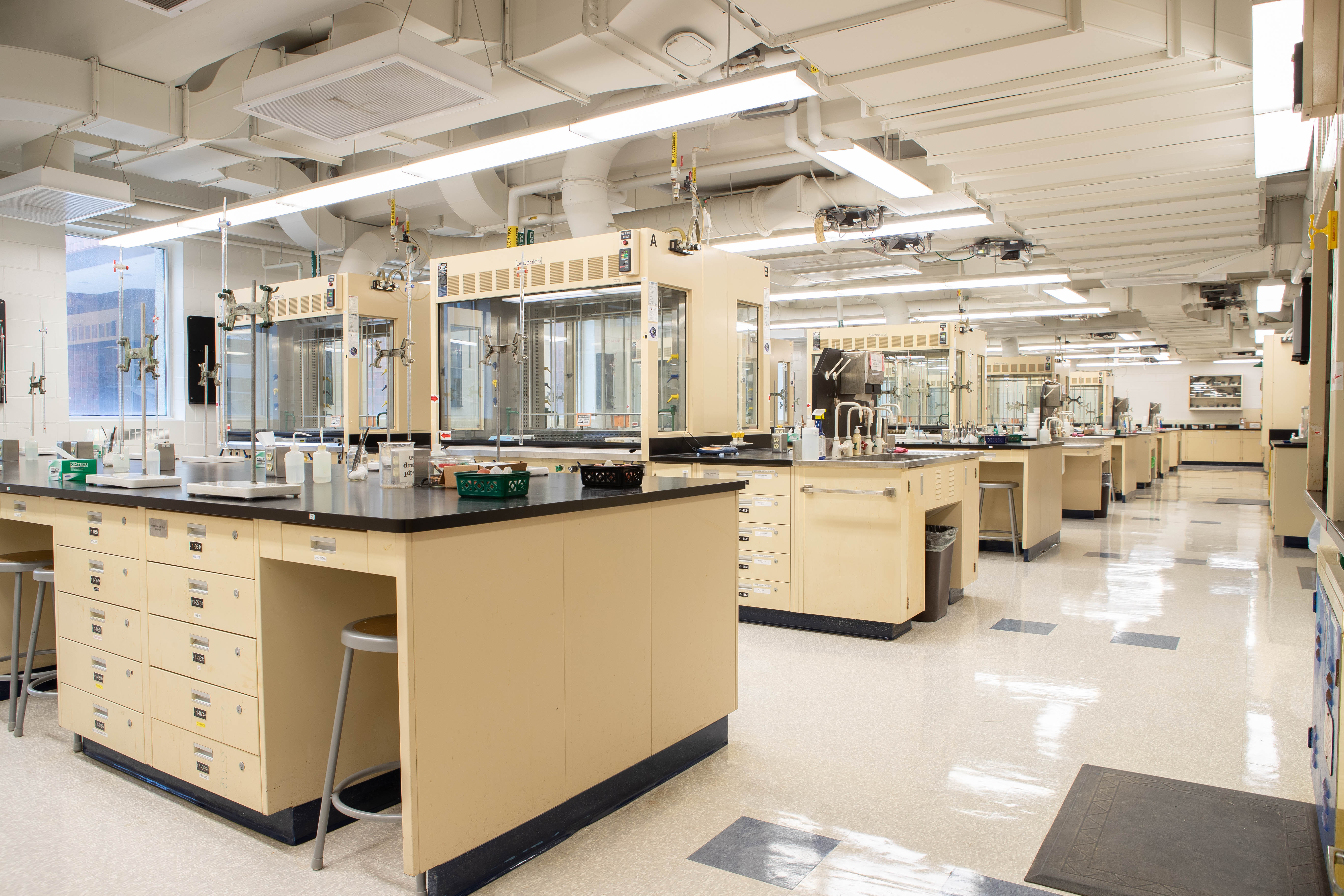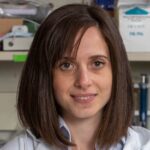Research Active Faculty
Information Box Group
Sara Andres
Assistant Professor
Director, Biomedical Discovery & Commercialization
Ph.D, McMaster University
Postdoctoral Fellowship, NIEHS, North Carolina
DNA repair, X-ray crystallography
Research
- DNA damage response and repair
- Drug resistant infections
- Structural biology
Drug resistant infections continuously challenge all forms of eukaryotic life including humans, plants and animals. Current antibiotic therapies against bacterial infections include those that damage the bacterial genome, however, DNA damage response and repair mechanisms lead to cell survival and drug resistant infections. Our lab is interested in understanding the molecular mechanisms of bacterial DNA damage response and repair through protein-protein and protein-DNA interactions and the role these interactions play in driving the evolution of antimicrobial resistance. We employ structural biology (x-ray crystallography, small-angle x-ray scattering and atomic force microscopy), biochemistry and molecular and cell biology to identify unique features of the DNA damage response and repair systems that can be exploited for new therapeutic strategies targeting pathogenic bacteria.

Sara Andres
Assistant Professor
Director, Biomedical Discovery & Commercialization
Ph.D, McMaster University
Postdoctoral Fellowship, NIEHS, North Carolina
DNA repair, X-ray crystallography
Mick Bhatia
Professor
Ph.D, University of Guelph
Postdoctoral Fellowship, University of Toronto
Stem cell biology, Cancer stem cells
Research
Mick Bhatia’s research examines the parallels between the behaviour of human stem cells and the initial stages of the development of human cancer, in order to advance understanding of how cancer begins.
Research Interests: human stem cell fate decisions, disease focus and translational impact, model systems and technologies

Mick Bhatia
Professor
Ph.D, University of Guelph
Postdoctoral Fellowship, University of Toronto
Stem cell biology, Cancer stem cells
Eric Brown
Professor
Canada Research Chair in Microbial Chemical Biology
Ph.D, University of Guelph
Postdoctoral Fellowship, Harvard Medical School
Microbial chemical biology, Chemical genomics
Research
- Microbiological biochemistry
- Antimicrobial research
Dr. Brown’s research interests are in studying complex and poorly understood aspects of biology in bacteria using molecular genetic and biochemical approaches. Brown lab researchers are currently studying cell wall and ribosome biogenesis, both daunting cellular processes of remarkable complexity. Further, Dr. Brown oversees an ambitious effort in chemical genomics aimed at mapping and understanding the interaction of drug-like small molecules with bacterial cell systems. In the past forty years, only two new classes of antibiotics have reached the clinic for treatment of bacterial infections. During this time, we have seen an alarming increase in reports of “superbugs” that are resistant to all existing antibiotics. Indeed, multi-drug resistance among bacterial pathogens is largely due to the limited number of drugs that eradicate bacteria with a narrow range of measures. Recognizing the need for new therapies with novel mechanisms of action, we have mounted research projects in areas of bacterial physiology of emerging importance in antibacterial drug discovery.

Eric Brown
Professor
Canada Research Chair in Microbial Chemical Biology
Ph.D, University of Guelph
Postdoctoral Fellowship, Harvard Medical School
Microbial chemical biology, Chemical genomics
Lori Burrows
Professor
Canada Research Chair in Microbe-Surface Interactions
Ph.D, University of Guelph
Postdoctoral Fellowship, University of Guelph
Molecular microbiology, Antibiotic resistance
Research
- Bacterial adhesins
- Biofilm formation
- Bacteriology, biochemistry, antimicrobial resistance
Many bacteria use retractable grappling hook-like fibers called type IV pili (T4P) to stick to and pull themselves along surfaces. T4P are related to type II secretion (T2S) systems used to release toxic proteins from the cell. We study these two systems in the opportunistic pathogen Pseudomonas aeruginosa with the goals of understanding their function and identifying vulnerabilities that could be exploited for drug development. T4P and T2S systems must cross the fence-like peptidoglycan layer that acts as a skeleton for the cell. We investigate how large protein complexes are inserted through this layer, which must remain intact for the cells to survive. Surface-attached bacterial communities called biofilms are important in environmental, medical and food safety-related processes. We study key biofilm developmental pathways by finding small molecules that increase or decrease biofilm formation by P. aeruginosa or Listeria monocytogenes, an important food-borne pathogen.

Lori Burrows
Professor
Canada Research Chair in Microbe-Surface Interactions
Ph.D, University of Guelph
Postdoctoral Fellowship, University of Guelph
Molecular microbiology, Antibiotic resistance
Brian Coombes
Professor and Chair
Ph.D, McMaster University
Postdoctoral Fellowship, University of British Columbia
Bacterial pathogenesis, Crohn's Disease
Research
- Microbiological biochemistry
- Antimicrobial research cell biology
- Gene regulation
- Bacterial pathogenesis, host-pathogen interactions
The Coombes laboratory investigates the genetics and molecular pathogenesis of human and animal infectious diseases. Coombes lab scientists use genetic, genomic and proteomics techniques to understand how bacterial virulence factors are expressed and function in the context of a host. We use model systems to then understand the complexity of the biological processes affected by these virulence factors, including subversion of the immune system, colonization dynamics and host damage. We have initiated research projects in four major areas that focus on the evolution, mechanisms and host responses to pathogenic processes caused by bacteria.

Brian Coombes
Professor and Chair
Ph.D, McMaster University
Postdoctoral Fellowship, University of British Columbia
Bacterial pathogenesis, Crohn's Disease
Cameron Currie
Professor
Jarislowsky Chair in Pandemic Research and Prevention
Ph.D, University of Toronto
Postdoctoral Fellowship, University of Texas at Austin
Insect-microbe symbioses, Microbial communities
Cameron Currie

Cameron Currie
Professor
Jarislowsky Chair in Pandemic Research and Prevention
Ph.D, University of Toronto
Postdoctoral Fellowship, University of Texas at Austin
Insect-microbe symbioses, Microbial communities
Radhey Gupta
Professor
Ph.D, University of Bombay
Postdoctoral Fellowship, University of Toronto
Phylogenomics, Comparative genomics
Research
- Comparative genomics
- Cell biology
- Microbial evolution
The Gupta Lab uses genome sequences to identify novel molecular markers that are useful for diagnostic, therapeutic and evolutionary studies.

Radhey Gupta
Professor
Ph.D, University of Bombay
Postdoctoral Fellowship, University of Toronto
Phylogenomics, Comparative genomics
Hong Han
Assistant Professor
Canada Research Chair in Cancer Systems Biology
Ph.D, University of Toronto
Postdoctoral Fellowship, University of Toronto
Cancer RNA Biology, Single-cell sequencing
Research Areas
- Alternative splicing regulation in cancer
- Multilayer mechanisms of glioblastoma heterogeneity and microenvironment evolution
- Multiplexed screening of gene/isoform function in treatment-resistant cancer and therapeutic discovery
The Han Lab works at the interface of cancer biology, RNA and multilayer gene regulation, and innovative high-throughput technologies. Dr. Han and her team have pioneered developing and applying several integrated technological platforms for large-scale genetic/drug screening and ultra-high-throughput single-cell profiling. Leveraging the power of these systematic experimental and computational approaches, together with in vitro, in vivo, and patient cohort studies, they discover multilayer regulatory mechanisms underlying cancer progression and RNA-multimodal therapeutics for treatment-resistant cancer. Her team strives to create a collaborative, supportive, and stimulating environment for multi-disciplinary cancer research.

Hong Han
Assistant Professor
Canada Research Chair in Cancer Systems Biology
Ph.D, University of Toronto
Postdoctoral Fellowship, University of Toronto
Cancer RNA Biology, Single-cell sequencing
Katie Houlahan
Assistant Professor
Ph.D, University of Toronto
Postdoctoral Fellowship, Stanford University
Cancer genomics, Computational oncology
The Houlahan lab applies statistical genetic approaches to large-scale cancer genomics data to uncover the role of inherited variation in somatic mutagenesis and tumour evolution. We systematically interrogate both tumour intrinsic mechanisms, i.e. transcriptional and epigenetic regulation, as well as tumor extrinsic mechanisms, i.e. immune surveillance, by which inherited variants modulate oncogenic mutations. We also investigate the impact inherited variants have on DNA alignment and downstream bioinformatic workflows. Taken together, our work will motivate novel biomarkers that can be measured from blood, making strides towards improved cancer screening and early detection.

Katie Houlahan
Assistant Professor
Ph.D, University of Toronto
Postdoctoral Fellowship, Stanford University
Cancer genomics, Computational oncology
Lindsay Kalan
Associate Professor
Canada Research Chair in Skin Microbiome and Infectious Disease
Ph.D, McMaster University
Postdoctoral Fellowship, University of Pennsylvania
Skin microbiome, Microbial interactions
Research Areas:
- Wound Healing and the Microbiome
Their research is focused on the body’s primary environmental barrier: the skin. Their interest lies in understanding how microbial communities assemble and interact with each other and their host across the different microenvironments of the skin. A healthy skin microbiome is important to maintain tissue homeostasis and educate the immune system. However, microbial imbalances are also associated with skin disorders and chronic cutaneous infection.
They use a highly inter-disciplinary approach that combines high-throughput technologies, such as deep sequencing and untargeted metabolomics, with bioinformatics and wet-lab experimental systems, to elucidate how this balance between beneficial and foreign microbes is maintained at the skin surface and in the context of non-healing chronic wounds.

Lindsay Kalan
Associate Professor
Canada Research Chair in Skin Microbiome and Infectious Disease
Ph.D, McMaster University
Postdoctoral Fellowship, University of Pennsylvania
Skin microbiome, Microbial interactions
Yingfu Li
Professor
Ph.D, Simon Fraser University
Postdoctoral Fellowship, Yale University
Functional nucleic acids, Directed evolution
Research
- Structural biology
- Protein/nucleic acid structure/protein
Our group works at the interface between chemistry and biology. Our overall research interest is to examine unusual functions of nucleic acids and to be creative about them. The molecules that we are interested in studying include artificial or natural single-stranded DNA or RNA molecules with often surprising properties. Our study on DNA or RNA has several distinct features. First, we examine DNA or RNA not for its well-recognized role as the genetic material to store and transmit genetic information for living organisms, but rather for its less-known utility as a simple polymer to carry out catalytic and binding functions. Second, we study DNA or RNA, not in their rigid double-stranded form, but in their flexible single-stranded configuration. Third, usually there is no natural source to fetch the DNA or RNA molecules for our study, but rather we create our own molecules using a technique called “in vitro selection”. In vitro selection is a simple yet powerful combinatorial approach that allows simultaneous screening of up to 1,016 different DNA or RNA molecules in a single mixture for rare sequences with unusual functions. It has been well demonstrated that nucleic acids, in addition to their roles in the storage and transmission of genetic information, can also act as enzymes (ribozymes and DNAzymes) and receptors (aptamers and riboswitches). My group is interested both in the study of basic functions of these molecules (basic science focus of the lab) and in the exploration of these molecules as novel molecular tools for therapeutics, biomolecular detection, drug discovery and nanotechnology (applied science focus of the lab).

Yingfu Li
Professor
Ph.D, Simon Fraser University
Postdoctoral Fellowship, Yale University
Functional nucleic acids, Directed evolution
Lesley MacNeil
Associate Professor
Ph.D, University of Toronto
Postdoctoral Fellowship, University of Massachusetts Medical School
C. elegans, Developmental biology
Research
- C. elegans research
- Diet, metabolism and microbiota
- Gene-environment interactions
- Cell biology, genetics, metabolism
Using the nematode C. elegansas a model system, the MacNeil lab investigates the mechanisms by which environmental factors, specifically diet and microbiota, influence health, development, disease susceptibility and disease progression. Currently, we are examining how these factors affect age-related disorders such as neurodegeneration. In addition to these specific disease models, we are employing high-throughput approaches to perform genome-scale mapping of gene-environment interactions to identify gene mutations that increase susceptibility to specific environmental factors.

Lesley MacNeil
Associate Professor
Ph.D, University of Toronto
Postdoctoral Fellowship, University of Massachusetts Medical School
C. elegans, Developmental biology
Nathan Magarvey
Associate Professor
Ph.D, University of Minnesota
Postdoctoral Fellowship, Harvard Medical School
Microbial natural products, Machine learning
Research
- Natural product biosynthesis and drug discovery
- Microbial metabolomics
- Small molecule/chemical signaling

Nathan Magarvey
Associate Professor
Ph.D, University of Minnesota
Postdoctoral Fellowship, Harvard Medical School
Microbial natural products, Machine learning
Jakob Magolan
Professor
Ph.D, University of Western Ontario
Postdoctoral Fellow, Griffith Institute for Drug Discovery, Brisbane
Medicinal chemistry, Organic synthesis
Research
- Pre-clinical drug discovery and development
- Organic synthetic methods
- Medicinal chemistry
In collaboration with biologists and biochemists, we pursue the discovery and pre-clinical development of pharmaceutical leads in a variety of therapeutic areas including antimicrobial, anti-pancreatic cancer and anti-depression. We specialize in the chemical synthesis of lead compounds and their structural derivatives with a particular interest in natural product-based leads. Our laboratory is also engaged in the development new strategies and methodologies for the efficient chemical synthesis.
Our current areas of focus include:
- New synthetic approaches to rare or unknown heterocyclic scaffolds
- Expanding the versatility of simple inexpensive substrates like dimethylsulfoxide (DMSO) as synthetic building blocks
- Use of heterogeneous reagents to enhance procedural efficiency and minimize the environmental impact of organic synthesis

Jakob Magolan
Professor
Ph.D, University of Western Ontario
Postdoctoral Fellow, Griffith Institute for Drug Discovery, Brisbane
Medicinal chemistry, Organic synthesis
Andrew McArthur
Professor
David Braley Chair in Computational Biology
Ph.D, University of Victoria
Postdoctoral Fellowship, Marine Biological Laboratory
Bioinformatics, Database design
Research
- Biological database design and predictive analytics, particularly in the areas of antimicrobial drug resistance and molecular epidemiology
- The Comprehensive Antibiotic Resistance Database
- Development of Integrated Health Biosystems research at McMaster University, bridging data-intensive biomedical research and clinical healthcare
- Bioinformatics workflows and Cloud computing for gene expression, gene regulation and population genomics
- Next generation DNA sequence analysis, genome assembly and genome annotation
- Molecular phylogenetics and phylogenomics
- Ecotoxicogenomics of environmental contaminants (metals, organics, pharmaceuticals) using zebrafish, mouse and other model systems
The McArthur Laboratory’s research program is rooted in bioinformatics, functional genomics and computational biology. It spans complex informatics approaches to the functional genomics of microbial drug resistance, development of biological databases, next generation sequencing for genome assembly and molecular epidemiology, automated literature curation approaches, controlled vocabularies for biological knowledge integration and functional genomics approaches in environmental toxicology. As part of our Cisco funded program, we also research the use and generation of ‘Big Data’ in the biomedical sciences, with the goal of integrating biomedical research and clinical healthcare.

Andrew McArthur
Professor
David Braley Chair in Computational Biology
Ph.D, University of Victoria
Postdoctoral Fellowship, Marine Biological Laboratory
Bioinformatics, Database design
Matthew Miller
Associate Professor
Scientific Director, Michael G. DeGroote Institute for Infectious Disease Research (IIDR)
Canada Research Chair in Viral Pandemics
Ph.D, University of Western Ontario
Postdoctoral Fellowship, Icahn School of Medicine, New York
Viral immunology, Influenza A virus
Research
- Virology, immunology
The Miller Laboratory is focused on understanding the intimate relationship between viral pathogens and their hosts. Upon infection, both the innate and the adaptive branches of the immune system are mobilized with the aim of protecting the host from virus-mediated pathologies. However, improper regulation of anti-viral immune responses can themselves lead to disease. In addition, viruses have – and continue to – evolve elegant strategies through which to avoid host-mediated immune recognition. Thus, understanding the qualities of immune responses which are effective in protecting the host, as well as those qualities that may cause harm, is essential to informing the development of novel vaccines and therapeutics. The Miller Laboratory is therefore interested in issues concerning both of the innate and adaptive branches of the antiviral response:
- The type I interferon system represents the primary innate response pathway initiated upon viral infection. Type I interferons elicit potent cell-intrinsic and cell-extrinsic mechanisms to combat infection. However, when improperly regulated, these responses can lead to devastating immunopathologies. Polymorphisms in genes responsible for regulation of the type I interferon response can therefore have a profound effect on the outcome of viral infections. Our group is interested in understanding how host genetics contribute to the pathological outcome of viral infections. Identification and characterization of these factors will be used to inform more personalized approaches to the treatment of infectious diseases.
- Abnormal inflammation is a signature of many neurodegenerative diseases. However, the way in which inflammation contributes to the pathology of these diseases is poorly defined. We are interested in understanding the role of inflammation in the etiology of neurodegenerative diseases, with a specific focus on its role in amyotrophic lateral sclerosis (ALS).
- Influenza A virus (IAV) presents a particularly formidable challenge to control by the humoral arm of the adaptive immune system. The virus has a segmented, RNA genome which is capable of both rapid mutation (contributing to “antigenic drift”) and re-assortment (which causes “antigenic shift”). These properties allow the virus to cause seasonal epidemics and periodic pandemics, respectively. Current-generation IAV vaccines must be administered seasonally and provide optimal protection against only a very limited number of IAV strains. However, a new class of antibodies has recently been discovered which is capable of providing much more broad protection across multiple IAV subtypes. Our group is focused on understanding the immunobiology of these antibodies, how they are elicited and how they may be useful for the generation of “universal” influenza virus vaccines and therapeutics.

Matthew Miller
Associate Professor
Scientific Director, Michael G. DeGroote Institute for Infectious Disease Research (IIDR)
Canada Research Chair in Viral Pandemics
Ph.D, University of Western Ontario
Postdoctoral Fellowship, Icahn School of Medicine, New York
Viral immunology, Influenza A virus
Jonathan Schertzer
Professor
Canada Research Chair in Metabolic Inflammation
Ph.D, University of Melbourne
Postdoctoral Fellowship, University of Toronto
Metabolism, Obesity, Diabetes
Research
- Metabolism, obesity, diabetes
The inability to respond to insulin is the major cause of type 2 diabetes. This insulin resistance
precedes overt diabetes, thereby providing therapeutic window to prevent the disease. Obesity is the main cause of insulin resistance and inflammation has emerged as a key link between obesity and insulin resistance. How does obesity cause inflammation and how does inflammation cause insulin resistance leading to diabetes? My laboratory is interested in understanding these problems in ImmunoMetabolism
and how dietary and bacterial factors connect immunology and metabolism. My laboratory uses physiology in genetic mouse models coupled with cell biology and biochemistry to understand the inflammatory basis of metabolic disease. Using our ImmunoMetabolism expertise, we collaborate with immunologists, microbiologists and gastroenterologists in order to understand how the food we eat and the bacteria that colonize us can cause (or prevent) metabolic diseases. This work is particularly interested in how the bacterial cell wall component, peptidoglycan and dietary factors such as saturated fat propagate inflammation and alter metabolism via nucleotide oligomerization domain (Nod) proteins.
This research has important implications for understanding the inflammatory underpinnings of obesity and diabetes and is complimentary to ongoing collaborative research on energy sensors and fat/glucose metabolism during obesity. My laboratory is also very interested in the role of inflammation in muscle diseases (i.e., myopathies). This builds on a long standing interest in basic science and therapeutics targeted to muscle using both endocrine and gene therapy approaches. Given that statin drugs are the first line treatment for obesity/diabetes related cardiovascular disease, we are particularly interested in immunity and statin-induced myopathy. Working with the world-renowned neuromuscular clinic at McMaster University, we bridge basic aspects of muscle biology and clinical treatment of myopathies such as muscular dystrophy, cancer cachexia, sarcopenia (aging) and inflammatory myopthies.
Selected Publications
- Gehrig SM, et al. HSP72 preserves muscle function and slows progression of severe muscular dystrophy. Nature, 484: 394-398, 2012
- Hawley SA, et al. The ancient drug salicylate directly activates AMP-activated protein kinase. Science, Apr 19, 2012
- Galic S, et al. Hematopoietic AMPK?1 reduces murine adipose tissue macrophage inflammation and hepatic insulin resistance in obesity. J Clin Invest, 121: 4903-4915, 2011
- O ‘Neill HM, et al. AMPK?1?2 muscle null mice reveal an essential role for AMPK in maintaining mitochondrial content and glucose uptake during exercise. Proc Natl Acad Sci USA, 108: 16092-7, 2011
- Schertzer JD and Klip A. Give a NOD to Insulin Resistance. Am J Physiol Endocrinol Metab 301: E585-6, 2011
- Schertzer JD, et al. NOD1 activators link innate immunity to insulin resistance. Diabetes 60: 2206-15, 2011
- Tamrakar AK, et al. NOD2 activation induces muscle cell-autonomous innate immune responses and insulin resistance. Endocrinology 151: 5624-5637, 2010
- Schertzer JD, et al. A transgenic mouse model to study GLUT4myc regulation in skeletal muscle. Endocrinology 150:1935-40, 2009
- Schertzer JD, et al. Modulation of IGF-I and IGFBP interactions enhances skeletal muscle regeneration and ameliorates the dystrophic pathology in mdx mice. Am J Pathol 171: 1180-8, 2007
- Schertzer JD and Lynch GS. Comparative evaluation of IGF-I gene transfer and IGF-I protein administration for enhancing skeletal muscle regeneration after injury. Gene Ther 13: 1657-64, 2006
- Schertzer JD, et al. Optimizing plasmid-based gene transfer for investigating skeletal muscle structure and function. Mol Ther 13: 795-803, 2006

Jonathan Schertzer
Professor
Canada Research Chair in Metabolic Inflammation
Ph.D, University of Melbourne
Postdoctoral Fellowship, University of Toronto
Metabolism, Obesity, Diabetes
Deborah Sloboda
Professor and Associate Chair Research
Canada Research Chair in Early Origins of Health and Disease
Ph.D, University of Toronto
Postdoctoral Fellowship, University of Auckland
Reproductive biology, Metabolism
Research
- Perinatal programming
- Reproduction
- Metabolism
Potential Graduate Student Projects
- Maternal nutritional compromise: effects on offspring ovarian clock gene signaling
- Role of melatonin in regulating reproductive and metabolic function in programmed animals
- Maternal obesity and offspring reproductive and metabolic outcome

Deborah Sloboda
Professor and Associate Chair Research
Canada Research Chair in Early Origins of Health and Disease
Ph.D, University of Toronto
Postdoctoral Fellowship, University of Auckland
Reproductive biology, Metabolism
Jon Stokes
Assistant Professor
Ph.D, McMaster University
Postdoctoral Fellowship, MIT
Microbial chemical biology, Machine learning
Research
- Microbial chemical biology
The Stokes Lab leverages a mindful balance of experimental and computational approaches to discover the next generation of life-saving antibiotics with novel structures and functions that expand the capabilities of these medicines beyond the current state of the art. One of our primary interests, quite broadly, is in the application of deep learning approaches to help us predict the antibacterial properties of structurally novel small molecules. Moreover, we seek to elucidate the molecular mechanisms underlying tolerance to antibiotics, which is the case where conventional bactericidal antibiotics fail to eradicate genetically antibiotic-susceptible bacterial cells. Indeed, these poorly understood antibiotic tolerant bacterial populations are responsible for prolonging antibiotic treatment durations in immunocompromised patients and facilitating the evolution of bona fide antibiotic resistance.

Jon Stokes
Assistant Professor
Ph.D, McMaster University
Postdoctoral Fellowship, MIT
Microbial chemical biology, Machine learning
Bernardo Trigatti
Professor
Ph.D, McMaster University
Postdoctoral Fellowship, MIT
Lipid transport, Atherosclerosis
Research
- Cell biology and regulation
- Atherosclerosis, high-density lipoprotein
Molecular Mechanisms of Atherosclerosis Development
Atherosclerosis is a major cause of heart disease and stroke among the leading causes of hospitalization and death in Western countries. It is a multifactorial disease involving a variety of physiological pathways. These include innate immunity, inflammation and lipoprotein metabolism. Our laboratory utilizes mouse molecular genetics to delineate the contribution of components of these pathways to the development of atherosclerosis. The mouse has been an extremely useful model genetic system to analyze pathways involved in atherosclerosis. In conventional mouse models of atherosclerosis, including the workhorse apoE and LDL receptor knockout mouse strains, atherosclerosis develops primarily in the aorta while coronary arteries, which feed the heart, appear resistant to disease. In contrast, mice that lack a receptor for high density lipoproteins develop extensive atherosclerosis in their coronary arteries as well as increased atherosclerosis in their aortas. These mice develop myocardial infarction as a result of the extensive coronary artery atherosclerosis. This suggests that the HDL receptor, called SR-BI, plays a key role in protection against coronary artery atherosclerosis.
One of the main focuses of the lab is to delineate the mechanisms by which expression of SR-BI in bone marrow derived cells including macrophages, protects against atherosclerosis. In particular, we are interested in understanding the role of this receptor in lipid transport as well as cell signalling. We are also making use of our mouse models of coronary artery atherosclerosis to delineate the factors that normally contribute to the resistance of mouse coronary arteries to atherosclerosis development, as well as to test the contribution of different physiological pathways to the development of coronary artery atherosclerosis and myocardial infarction.

Bernardo Trigatti
Professor
Ph.D, McMaster University
Postdoctoral Fellowship, MIT
Lipid transport, Atherosclerosis
Ray Truant
Professor
Ph.D, University of Toronto
Postdoctoral Fellowship, Duke University
Cell biology, Huntington's disease
Research
- Cell biology and regulation
- Huntington’s disease
Our laboratory is interested in how proteins move throughout the cell’s organelles in humans. We have successfully implemented and developed new tools to look at how proteins move within live cells. We are also interested in the discovery of new protein-protein interactions by biochemical methods in vitro, and analyzing these interactions in living cells in vivo. We are currently focusing our research on a series of genetically inherited neurodegenerative diseases that all have one basic biochemical defect in common: CAG DNA sequences >36 repeats in the gene’s open reading frame that translate to glutamine amino acid stretches in the disease protein. These diseases are collectively referred to as Polyglutamine expansion diseases and include SBMA, DRPLA, HD, SCAs 1,2,3,6,7 and 17. We are actively involved in trying to determine the normal functions of huntingtin and what the overall biological role of huntingtin is in every living human cell, and how mutant huntingtin exactly leads to Huntington’s disease (HD).

Ray Truant
Professor
Ph.D, University of Toronto
Postdoctoral Fellowship, Duke University
Cell biology, Huntington's disease
John Whitney
Associate Professor and Associate Chair Graduate Studies
Canada Research Chair in Molecular Microbiology
Ph.D, University of Toronto
Postdoctoral Fellowship, University of Washington
Molecular microbiology, Bacterial secretion systems
Research
- Interbacterial competition
- Microbial communities
- Bacterial cell surface structures
- Structure/function of bacterial toxins
- Biochemistry, bacteriology, structural biology
Type VI Secretion:
The bacterial type VI secretion system is a recently identified protein translocation pathway used by Gram-negative bacteria to deliver toxins to neighbouring bacteria in a cell contact-dependent manner. We are interested in understanding how these antibacterial proteins are transported from one cell to another and how they exert toxicity once delivered to a target cell. By understanding the molecular principles underlying this process it is our long term goal to be able to rationally manipulate bacterial populations relevant to human health.
Bacterial Adhesion:
Many species of bacteria exist in dense cellular aggregates held together by bacterially produced exopolysaccharides. In this form, bacteria are difficult to eradicate due, in part, to decreased efficacy of antibiotics. We are interested in determining how bacterial exopolysaccharides are synthesized and exported from the cell. By understanding how this process occurs at the molecular level, we hope to one day be able to inhibit exopolysaccharide secretion under circumstances where it is detrimental to human activities (i.e., biofouling of pipes, colonization of indwelling medical devices, etc.).

John Whitney
Associate Professor and Associate Chair Graduate Studies
Canada Research Chair in Molecular Microbiology
Ph.D, University of Toronto
Postdoctoral Fellowship, University of Washington
Molecular microbiology, Bacterial secretion systems
Dawit Wolday
Associate Professor
Ph.D, Karolinska Institute
Chronic immune activation, Pathogen genomic epidemiology
Dr. Dawit received his MD (1987) and MSc (1993) in Medical Microbiology from Addis Ababa University, Ethiopia. He then completed his PhD in the Department of Microbiology, Tumor and Cell Biology (2000) at Karolinska Institute in Sweden. In 2022, Dawit was working at the Lunenfeld-Tanenbaum Research Institute, Sinai Health Systems, in Toronto, before joining the Department of Biochemistry and Biomedical Sciences at McMaster University in 2023.
His research interests focus on the role of chronic immune activation on the pathophysiology of disease progression of viral diseases, and pathogen genomic epidemiology in low-income countries. Dr. Dawit has received several research grant awards, and has published 115 scientific manuscripts in peer-reviewed journals, and 2 book sections. He is also a Senior Research Fellow of the European and Developing Countries Clinical Trial Partnership (EDCTP).

Dawit Wolday
Associate Professor
Ph.D, Karolinska Institute
Chronic immune activation, Pathogen genomic epidemiology
Gerard Wright
Professor
Ph.D, University of Waterloo
Postdoctoral Fellowship, Harvard Medical School
Microbial natural products, Antibiotic resistance
Research
- Microbiological biochemistry
- Antimicrobial research
- Antibiotic resistance
The discovery of antibiotic compounds derived from microorganisms some 50 years ago has provided an arsenal of drugs for the treatment of infectious diseases. Unfortunately, many pathogenic organisms have acquired resistance to antibiotics and now some infections are virtually untreatable by standard antibiotic therapies. In order to address this problem, we are using three complementary strategies. The first is direct study of the molecular mechanisms of bacterial antibiotic resistance, the second is the elucidation of antibiotic biosynthesis with the ultimate goal of manipulating the biosynthetic pathway to produce novel antibiotics.

Gerard Wright
Professor
Ph.D, University of Waterloo
Postdoctoral Fellowship, Harvard Medical School
Microbial natural products, Antibiotic resistance
Sara Andres
Assistant Professor
Director, Biomedical Discovery & Commercialization
Ph.D, McMaster University
Postdoctoral Fellowship, NIEHS, North Carolina
DNA repair, X-ray crystallography
Research
- DNA damage response and repair
- Drug resistant infections
- Structural biology
Drug resistant infections continuously challenge all forms of eukaryotic life including humans, plants and animals. Current antibiotic therapies against bacterial infections include those that damage the bacterial genome, however, DNA damage response and repair mechanisms lead to cell survival and drug resistant infections. Our lab is interested in understanding the molecular mechanisms of bacterial DNA damage response and repair through protein-protein and protein-DNA interactions and the role these interactions play in driving the evolution of antimicrobial resistance. We employ structural biology (x-ray crystallography, small-angle x-ray scattering and atomic force microscopy), biochemistry and molecular and cell biology to identify unique features of the DNA damage response and repair systems that can be exploited for new therapeutic strategies targeting pathogenic bacteria.
Sara Andres
Assistant Professor
Director, Biomedical Discovery & Commercialization
Ph.D, McMaster University
Postdoctoral Fellowship, NIEHS, North Carolina
DNA repair, X-ray crystallography
Research
- DNA damage response and repair
- Drug resistant infections
- Structural biology
Drug resistant infections continuously challenge all forms of eukaryotic life including humans, plants and animals. Current antibiotic therapies against bacterial infections include those that damage the bacterial genome, however, DNA damage response and repair mechanisms lead to cell survival and drug resistant infections. Our lab is interested in understanding the molecular mechanisms of bacterial DNA damage response and repair through protein-protein and protein-DNA interactions and the role these interactions play in driving the evolution of antimicrobial resistance. We employ structural biology (x-ray crystallography, small-angle x-ray scattering and atomic force microscopy), biochemistry and molecular and cell biology to identify unique features of the DNA damage response and repair systems that can be exploited for new therapeutic strategies targeting pathogenic bacteria.
Mick Bhatia
Professor
Ph.D, University of Guelph
Postdoctoral Fellowship, University of Toronto
Stem cell biology, Cancer stem cells
Research
Mick Bhatia’s research examines the parallels between the behaviour of human stem cells and the initial stages of the development of human cancer, in order to advance understanding of how cancer begins.
Research Interests: human stem cell fate decisions, disease focus and translational impact, model systems and technologies
Mick Bhatia
Professor
Ph.D, University of Guelph
Postdoctoral Fellowship, University of Toronto
Stem cell biology, Cancer stem cells
Research
Mick Bhatia’s research examines the parallels between the behaviour of human stem cells and the initial stages of the development of human cancer, in order to advance understanding of how cancer begins.
Research Interests: human stem cell fate decisions, disease focus and translational impact, model systems and technologies
Eric Brown
Professor
Canada Research Chair in Microbial Chemical Biology
Ph.D, University of Guelph
Postdoctoral Fellowship, Harvard Medical School
Microbial chemical biology, Chemical genomics
Research
- Microbiological biochemistry
- Antimicrobial research
Dr. Brown’s research interests are in studying complex and poorly understood aspects of biology in bacteria using molecular genetic and biochemical approaches. Brown lab researchers are currently studying cell wall and ribosome biogenesis, both daunting cellular processes of remarkable complexity. Further, Dr. Brown oversees an ambitious effort in chemical genomics aimed at mapping and understanding the interaction of drug-like small molecules with bacterial cell systems. In the past forty years, only two new classes of antibiotics have reached the clinic for treatment of bacterial infections. During this time, we have seen an alarming increase in reports of “superbugs” that are resistant to all existing antibiotics. Indeed, multi-drug resistance among bacterial pathogens is largely due to the limited number of drugs that eradicate bacteria with a narrow range of measures. Recognizing the need for new therapies with novel mechanisms of action, we have mounted research projects in areas of bacterial physiology of emerging importance in antibacterial drug discovery.
Eric Brown
Professor
Canada Research Chair in Microbial Chemical Biology
Ph.D, University of Guelph
Postdoctoral Fellowship, Harvard Medical School
Microbial chemical biology, Chemical genomics
Research
- Microbiological biochemistry
- Antimicrobial research
Dr. Brown’s research interests are in studying complex and poorly understood aspects of biology in bacteria using molecular genetic and biochemical approaches. Brown lab researchers are currently studying cell wall and ribosome biogenesis, both daunting cellular processes of remarkable complexity. Further, Dr. Brown oversees an ambitious effort in chemical genomics aimed at mapping and understanding the interaction of drug-like small molecules with bacterial cell systems. In the past forty years, only two new classes of antibiotics have reached the clinic for treatment of bacterial infections. During this time, we have seen an alarming increase in reports of “superbugs” that are resistant to all existing antibiotics. Indeed, multi-drug resistance among bacterial pathogens is largely due to the limited number of drugs that eradicate bacteria with a narrow range of measures. Recognizing the need for new therapies with novel mechanisms of action, we have mounted research projects in areas of bacterial physiology of emerging importance in antibacterial drug discovery.
Lori Burrows
Professor
Canada Research Chair in Microbe-Surface Interactions
Ph.D, University of Guelph
Postdoctoral Fellowship, University of Guelph
Molecular microbiology, Antibiotic resistance
Research
- Bacterial adhesins
- Biofilm formation
- Bacteriology, biochemistry, antimicrobial resistance
Many bacteria use retractable grappling hook-like fibers called type IV pili (T4P) to stick to and pull themselves along surfaces. T4P are related to type II secretion (T2S) systems used to release toxic proteins from the cell. We study these two systems in the opportunistic pathogen Pseudomonas aeruginosa with the goals of understanding their function and identifying vulnerabilities that could be exploited for drug development. T4P and T2S systems must cross the fence-like peptidoglycan layer that acts as a skeleton for the cell. We investigate how large protein complexes are inserted through this layer, which must remain intact for the cells to survive. Surface-attached bacterial communities called biofilms are important in environmental, medical and food safety-related processes. We study key biofilm developmental pathways by finding small molecules that increase or decrease biofilm formation by P. aeruginosa or Listeria monocytogenes, an important food-borne pathogen.
Lori Burrows
Professor
Canada Research Chair in Microbe-Surface Interactions
Ph.D, University of Guelph
Postdoctoral Fellowship, University of Guelph
Molecular microbiology, Antibiotic resistance
Research
- Bacterial adhesins
- Biofilm formation
- Bacteriology, biochemistry, antimicrobial resistance
Many bacteria use retractable grappling hook-like fibers called type IV pili (T4P) to stick to and pull themselves along surfaces. T4P are related to type II secretion (T2S) systems used to release toxic proteins from the cell. We study these two systems in the opportunistic pathogen Pseudomonas aeruginosa with the goals of understanding their function and identifying vulnerabilities that could be exploited for drug development. T4P and T2S systems must cross the fence-like peptidoglycan layer that acts as a skeleton for the cell. We investigate how large protein complexes are inserted through this layer, which must remain intact for the cells to survive. Surface-attached bacterial communities called biofilms are important in environmental, medical and food safety-related processes. We study key biofilm developmental pathways by finding small molecules that increase or decrease biofilm formation by P. aeruginosa or Listeria monocytogenes, an important food-borne pathogen.
Brian Coombes
Professor and Chair
Ph.D, McMaster University
Postdoctoral Fellowship, University of British Columbia
Bacterial pathogenesis, Crohn's Disease
Research
- Microbiological biochemistry
- Antimicrobial research cell biology
- Gene regulation
- Bacterial pathogenesis, host-pathogen interactions
The Coombes laboratory investigates the genetics and molecular pathogenesis of human and animal infectious diseases. Coombes lab scientists use genetic, genomic and proteomics techniques to understand how bacterial virulence factors are expressed and function in the context of a host. We use model systems to then understand the complexity of the biological processes affected by these virulence factors, including subversion of the immune system, colonization dynamics and host damage. We have initiated research projects in four major areas that focus on the evolution, mechanisms and host responses to pathogenic processes caused by bacteria.
Brian Coombes
Professor and Chair
Ph.D, McMaster University
Postdoctoral Fellowship, University of British Columbia
Bacterial pathogenesis, Crohn's Disease
Research
- Microbiological biochemistry
- Antimicrobial research cell biology
- Gene regulation
- Bacterial pathogenesis, host-pathogen interactions
The Coombes laboratory investigates the genetics and molecular pathogenesis of human and animal infectious diseases. Coombes lab scientists use genetic, genomic and proteomics techniques to understand how bacterial virulence factors are expressed and function in the context of a host. We use model systems to then understand the complexity of the biological processes affected by these virulence factors, including subversion of the immune system, colonization dynamics and host damage. We have initiated research projects in four major areas that focus on the evolution, mechanisms and host responses to pathogenic processes caused by bacteria.
Cameron Currie
Professor
Jarislowsky Chair in Pandemic Research and Prevention
Ph.D, University of Toronto
Postdoctoral Fellowship, University of Texas at Austin
Insect-microbe symbioses, Microbial communities
Cameron Currie
Cameron Currie
Professor
Jarislowsky Chair in Pandemic Research and Prevention
Ph.D, University of Toronto
Postdoctoral Fellowship, University of Texas at Austin
Insect-microbe symbioses, Microbial communities
Cameron Currie
Radhey Gupta
Professor
Ph.D, University of Bombay
Postdoctoral Fellowship, University of Toronto
Phylogenomics, Comparative genomics
Research
- Comparative genomics
- Cell biology
- Microbial evolution
The Gupta Lab uses genome sequences to identify novel molecular markers that are useful for diagnostic, therapeutic and evolutionary studies.
Radhey Gupta
Professor
Ph.D, University of Bombay
Postdoctoral Fellowship, University of Toronto
Phylogenomics, Comparative genomics
Research
- Comparative genomics
- Cell biology
- Microbial evolution
The Gupta Lab uses genome sequences to identify novel molecular markers that are useful for diagnostic, therapeutic and evolutionary studies.
Hong Han
Assistant Professor
Canada Research Chair in Cancer Systems Biology
Ph.D, University of Toronto
Postdoctoral Fellowship, University of Toronto
Cancer RNA Biology, Single-cell sequencing
Research Areas
- Alternative splicing regulation in cancer
- Multilayer mechanisms of glioblastoma heterogeneity and microenvironment evolution
- Multiplexed screening of gene/isoform function in treatment-resistant cancer and therapeutic discovery
The Han Lab works at the interface of cancer biology, RNA and multilayer gene regulation, and innovative high-throughput technologies. Dr. Han and her team have pioneered developing and applying several integrated technological platforms for large-scale genetic/drug screening and ultra-high-throughput single-cell profiling. Leveraging the power of these systematic experimental and computational approaches, together with in vitro, in vivo, and patient cohort studies, they discover multilayer regulatory mechanisms underlying cancer progression and RNA-multimodal therapeutics for treatment-resistant cancer. Her team strives to create a collaborative, supportive, and stimulating environment for multi-disciplinary cancer research.
Hong Han
Assistant Professor
Canada Research Chair in Cancer Systems Biology
Ph.D, University of Toronto
Postdoctoral Fellowship, University of Toronto
Cancer RNA Biology, Single-cell sequencing
Research Areas
- Alternative splicing regulation in cancer
- Multilayer mechanisms of glioblastoma heterogeneity and microenvironment evolution
- Multiplexed screening of gene/isoform function in treatment-resistant cancer and therapeutic discovery
The Han Lab works at the interface of cancer biology, RNA and multilayer gene regulation, and innovative high-throughput technologies. Dr. Han and her team have pioneered developing and applying several integrated technological platforms for large-scale genetic/drug screening and ultra-high-throughput single-cell profiling. Leveraging the power of these systematic experimental and computational approaches, together with in vitro, in vivo, and patient cohort studies, they discover multilayer regulatory mechanisms underlying cancer progression and RNA-multimodal therapeutics for treatment-resistant cancer. Her team strives to create a collaborative, supportive, and stimulating environment for multi-disciplinary cancer research.
Katie Houlahan
Assistant Professor
Ph.D, University of Toronto
Postdoctoral Fellowship, Stanford University
Cancer genomics, Computational oncology
The Houlahan lab applies statistical genetic approaches to large-scale cancer genomics data to uncover the role of inherited variation in somatic mutagenesis and tumour evolution. We systematically interrogate both tumour intrinsic mechanisms, i.e. transcriptional and epigenetic regulation, as well as tumor extrinsic mechanisms, i.e. immune surveillance, by which inherited variants modulate oncogenic mutations. We also investigate the impact inherited variants have on DNA alignment and downstream bioinformatic workflows. Taken together, our work will motivate novel biomarkers that can be measured from blood, making strides towards improved cancer screening and early detection.
Katie Houlahan
Assistant Professor
Ph.D, University of Toronto
Postdoctoral Fellowship, Stanford University
Cancer genomics, Computational oncology
The Houlahan lab applies statistical genetic approaches to large-scale cancer genomics data to uncover the role of inherited variation in somatic mutagenesis and tumour evolution. We systematically interrogate both tumour intrinsic mechanisms, i.e. transcriptional and epigenetic regulation, as well as tumor extrinsic mechanisms, i.e. immune surveillance, by which inherited variants modulate oncogenic mutations. We also investigate the impact inherited variants have on DNA alignment and downstream bioinformatic workflows. Taken together, our work will motivate novel biomarkers that can be measured from blood, making strides towards improved cancer screening and early detection.
Lindsay Kalan
Associate Professor
Canada Research Chair in Skin Microbiome and Infectious Disease
Ph.D, McMaster University
Postdoctoral Fellowship, University of Pennsylvania
Skin microbiome, Microbial interactions
Research Areas:
- Wound Healing and the Microbiome
Their research is focused on the body’s primary environmental barrier: the skin. Their interest lies in understanding how microbial communities assemble and interact with each other and their host across the different microenvironments of the skin. A healthy skin microbiome is important to maintain tissue homeostasis and educate the immune system. However, microbial imbalances are also associated with skin disorders and chronic cutaneous infection.
They use a highly inter-disciplinary approach that combines high-throughput technologies, such as deep sequencing and untargeted metabolomics, with bioinformatics and wet-lab experimental systems, to elucidate how this balance between beneficial and foreign microbes is maintained at the skin surface and in the context of non-healing chronic wounds.
Lindsay Kalan
Associate Professor
Canada Research Chair in Skin Microbiome and Infectious Disease
Ph.D, McMaster University
Postdoctoral Fellowship, University of Pennsylvania
Skin microbiome, Microbial interactions
Research Areas:
- Wound Healing and the Microbiome
Their research is focused on the body’s primary environmental barrier: the skin. Their interest lies in understanding how microbial communities assemble and interact with each other and their host across the different microenvironments of the skin. A healthy skin microbiome is important to maintain tissue homeostasis and educate the immune system. However, microbial imbalances are also associated with skin disorders and chronic cutaneous infection.
They use a highly inter-disciplinary approach that combines high-throughput technologies, such as deep sequencing and untargeted metabolomics, with bioinformatics and wet-lab experimental systems, to elucidate how this balance between beneficial and foreign microbes is maintained at the skin surface and in the context of non-healing chronic wounds.
Yingfu Li
Professor
Ph.D, Simon Fraser University
Postdoctoral Fellowship, Yale University
Functional nucleic acids, Directed evolution
Research
- Structural biology
- Protein/nucleic acid structure/protein
Our group works at the interface between chemistry and biology. Our overall research interest is to examine unusual functions of nucleic acids and to be creative about them. The molecules that we are interested in studying include artificial or natural single-stranded DNA or RNA molecules with often surprising properties. Our study on DNA or RNA has several distinct features. First, we examine DNA or RNA not for its well-recognized role as the genetic material to store and transmit genetic information for living organisms, but rather for its less-known utility as a simple polymer to carry out catalytic and binding functions. Second, we study DNA or RNA, not in their rigid double-stranded form, but in their flexible single-stranded configuration. Third, usually there is no natural source to fetch the DNA or RNA molecules for our study, but rather we create our own molecules using a technique called “in vitro selection”. In vitro selection is a simple yet powerful combinatorial approach that allows simultaneous screening of up to 1,016 different DNA or RNA molecules in a single mixture for rare sequences with unusual functions. It has been well demonstrated that nucleic acids, in addition to their roles in the storage and transmission of genetic information, can also act as enzymes (ribozymes and DNAzymes) and receptors (aptamers and riboswitches). My group is interested both in the study of basic functions of these molecules (basic science focus of the lab) and in the exploration of these molecules as novel molecular tools for therapeutics, biomolecular detection, drug discovery and nanotechnology (applied science focus of the lab).
Yingfu Li
Professor
Ph.D, Simon Fraser University
Postdoctoral Fellowship, Yale University
Functional nucleic acids, Directed evolution
Research
- Structural biology
- Protein/nucleic acid structure/protein
Our group works at the interface between chemistry and biology. Our overall research interest is to examine unusual functions of nucleic acids and to be creative about them. The molecules that we are interested in studying include artificial or natural single-stranded DNA or RNA molecules with often surprising properties. Our study on DNA or RNA has several distinct features. First, we examine DNA or RNA not for its well-recognized role as the genetic material to store and transmit genetic information for living organisms, but rather for its less-known utility as a simple polymer to carry out catalytic and binding functions. Second, we study DNA or RNA, not in their rigid double-stranded form, but in their flexible single-stranded configuration. Third, usually there is no natural source to fetch the DNA or RNA molecules for our study, but rather we create our own molecules using a technique called “in vitro selection”. In vitro selection is a simple yet powerful combinatorial approach that allows simultaneous screening of up to 1,016 different DNA or RNA molecules in a single mixture for rare sequences with unusual functions. It has been well demonstrated that nucleic acids, in addition to their roles in the storage and transmission of genetic information, can also act as enzymes (ribozymes and DNAzymes) and receptors (aptamers and riboswitches). My group is interested both in the study of basic functions of these molecules (basic science focus of the lab) and in the exploration of these molecules as novel molecular tools for therapeutics, biomolecular detection, drug discovery and nanotechnology (applied science focus of the lab).
Lesley MacNeil
Associate Professor
Ph.D, University of Toronto
Postdoctoral Fellowship, University of Massachusetts Medical School
C. elegans, Developmental biology
Research
- C. elegans research
- Diet, metabolism and microbiota
- Gene-environment interactions
- Cell biology, genetics, metabolism
Using the nematode C. elegansas a model system, the MacNeil lab investigates the mechanisms by which environmental factors, specifically diet and microbiota, influence health, development, disease susceptibility and disease progression. Currently, we are examining how these factors affect age-related disorders such as neurodegeneration. In addition to these specific disease models, we are employing high-throughput approaches to perform genome-scale mapping of gene-environment interactions to identify gene mutations that increase susceptibility to specific environmental factors.
Lesley MacNeil
Associate Professor
Ph.D, University of Toronto
Postdoctoral Fellowship, University of Massachusetts Medical School
C. elegans, Developmental biology
Research
- C. elegans research
- Diet, metabolism and microbiota
- Gene-environment interactions
- Cell biology, genetics, metabolism
Using the nematode C. elegansas a model system, the MacNeil lab investigates the mechanisms by which environmental factors, specifically diet and microbiota, influence health, development, disease susceptibility and disease progression. Currently, we are examining how these factors affect age-related disorders such as neurodegeneration. In addition to these specific disease models, we are employing high-throughput approaches to perform genome-scale mapping of gene-environment interactions to identify gene mutations that increase susceptibility to specific environmental factors.
Nathan Magarvey
Associate Professor
Ph.D, University of Minnesota
Postdoctoral Fellowship, Harvard Medical School
Microbial natural products, Machine learning
Research
- Natural product biosynthesis and drug discovery
- Microbial metabolomics
- Small molecule/chemical signaling
Nathan Magarvey
Associate Professor
Ph.D, University of Minnesota
Postdoctoral Fellowship, Harvard Medical School
Microbial natural products, Machine learning
Research
- Natural product biosynthesis and drug discovery
- Microbial metabolomics
- Small molecule/chemical signaling
Jakob Magolan
Professor
Ph.D, University of Western Ontario
Postdoctoral Fellow, Griffith Institute for Drug Discovery, Brisbane
Medicinal chemistry, Organic synthesis
Research
- Pre-clinical drug discovery and development
- Organic synthetic methods
- Medicinal chemistry
In collaboration with biologists and biochemists, we pursue the discovery and pre-clinical development of pharmaceutical leads in a variety of therapeutic areas including antimicrobial, anti-pancreatic cancer and anti-depression. We specialize in the chemical synthesis of lead compounds and their structural derivatives with a particular interest in natural product-based leads. Our laboratory is also engaged in the development new strategies and methodologies for the efficient chemical synthesis.
Our current areas of focus include:
- New synthetic approaches to rare or unknown heterocyclic scaffolds
- Expanding the versatility of simple inexpensive substrates like dimethylsulfoxide (DMSO) as synthetic building blocks
- Use of heterogeneous reagents to enhance procedural efficiency and minimize the environmental impact of organic synthesis
Jakob Magolan
Professor
Ph.D, University of Western Ontario
Postdoctoral Fellow, Griffith Institute for Drug Discovery, Brisbane
Medicinal chemistry, Organic synthesis
Research
- Pre-clinical drug discovery and development
- Organic synthetic methods
- Medicinal chemistry
In collaboration with biologists and biochemists, we pursue the discovery and pre-clinical development of pharmaceutical leads in a variety of therapeutic areas including antimicrobial, anti-pancreatic cancer and anti-depression. We specialize in the chemical synthesis of lead compounds and their structural derivatives with a particular interest in natural product-based leads. Our laboratory is also engaged in the development new strategies and methodologies for the efficient chemical synthesis.
Our current areas of focus include:
- New synthetic approaches to rare or unknown heterocyclic scaffolds
- Expanding the versatility of simple inexpensive substrates like dimethylsulfoxide (DMSO) as synthetic building blocks
- Use of heterogeneous reagents to enhance procedural efficiency and minimize the environmental impact of organic synthesis
Andrew McArthur
Professor
David Braley Chair in Computational Biology
Ph.D, University of Victoria
Postdoctoral Fellowship, Marine Biological Laboratory
Bioinformatics, Database design
Research
- Biological database design and predictive analytics, particularly in the areas of antimicrobial drug resistance and molecular epidemiology
- The Comprehensive Antibiotic Resistance Database
- Development of Integrated Health Biosystems research at McMaster University, bridging data-intensive biomedical research and clinical healthcare
- Bioinformatics workflows and Cloud computing for gene expression, gene regulation and population genomics
- Next generation DNA sequence analysis, genome assembly and genome annotation
- Molecular phylogenetics and phylogenomics
- Ecotoxicogenomics of environmental contaminants (metals, organics, pharmaceuticals) using zebrafish, mouse and other model systems
The McArthur Laboratory’s research program is rooted in bioinformatics, functional genomics and computational biology. It spans complex informatics approaches to the functional genomics of microbial drug resistance, development of biological databases, next generation sequencing for genome assembly and molecular epidemiology, automated literature curation approaches, controlled vocabularies for biological knowledge integration and functional genomics approaches in environmental toxicology. As part of our Cisco funded program, we also research the use and generation of ‘Big Data’ in the biomedical sciences, with the goal of integrating biomedical research and clinical healthcare.
Andrew McArthur
Professor
David Braley Chair in Computational Biology
Ph.D, University of Victoria
Postdoctoral Fellowship, Marine Biological Laboratory
Bioinformatics, Database design
Research
- Biological database design and predictive analytics, particularly in the areas of antimicrobial drug resistance and molecular epidemiology
- The Comprehensive Antibiotic Resistance Database
- Development of Integrated Health Biosystems research at McMaster University, bridging data-intensive biomedical research and clinical healthcare
- Bioinformatics workflows and Cloud computing for gene expression, gene regulation and population genomics
- Next generation DNA sequence analysis, genome assembly and genome annotation
- Molecular phylogenetics and phylogenomics
- Ecotoxicogenomics of environmental contaminants (metals, organics, pharmaceuticals) using zebrafish, mouse and other model systems
The McArthur Laboratory’s research program is rooted in bioinformatics, functional genomics and computational biology. It spans complex informatics approaches to the functional genomics of microbial drug resistance, development of biological databases, next generation sequencing for genome assembly and molecular epidemiology, automated literature curation approaches, controlled vocabularies for biological knowledge integration and functional genomics approaches in environmental toxicology. As part of our Cisco funded program, we also research the use and generation of ‘Big Data’ in the biomedical sciences, with the goal of integrating biomedical research and clinical healthcare.
Matthew Miller
Associate Professor
Scientific Director, Michael G. DeGroote Institute for Infectious Disease Research (IIDR)
Canada Research Chair in Viral Pandemics
Ph.D, University of Western Ontario
Postdoctoral Fellowship, Icahn School of Medicine, New York
Viral immunology, Influenza A virus
Research
- Virology, immunology
The Miller Laboratory is focused on understanding the intimate relationship between viral pathogens and their hosts. Upon infection, both the innate and the adaptive branches of the immune system are mobilized with the aim of protecting the host from virus-mediated pathologies. However, improper regulation of anti-viral immune responses can themselves lead to disease. In addition, viruses have – and continue to – evolve elegant strategies through which to avoid host-mediated immune recognition. Thus, understanding the qualities of immune responses which are effective in protecting the host, as well as those qualities that may cause harm, is essential to informing the development of novel vaccines and therapeutics. The Miller Laboratory is therefore interested in issues concerning both of the innate and adaptive branches of the antiviral response:
- The type I interferon system represents the primary innate response pathway initiated upon viral infection. Type I interferons elicit potent cell-intrinsic and cell-extrinsic mechanisms to combat infection. However, when improperly regulated, these responses can lead to devastating immunopathologies. Polymorphisms in genes responsible for regulation of the type I interferon response can therefore have a profound effect on the outcome of viral infections. Our group is interested in understanding how host genetics contribute to the pathological outcome of viral infections. Identification and characterization of these factors will be used to inform more personalized approaches to the treatment of infectious diseases.
- Abnormal inflammation is a signature of many neurodegenerative diseases. However, the way in which inflammation contributes to the pathology of these diseases is poorly defined. We are interested in understanding the role of inflammation in the etiology of neurodegenerative diseases, with a specific focus on its role in amyotrophic lateral sclerosis (ALS).
- Influenza A virus (IAV) presents a particularly formidable challenge to control by the humoral arm of the adaptive immune system. The virus has a segmented, RNA genome which is capable of both rapid mutation (contributing to “antigenic drift”) and re-assortment (which causes “antigenic shift”). These properties allow the virus to cause seasonal epidemics and periodic pandemics, respectively. Current-generation IAV vaccines must be administered seasonally and provide optimal protection against only a very limited number of IAV strains. However, a new class of antibodies has recently been discovered which is capable of providing much more broad protection across multiple IAV subtypes. Our group is focused on understanding the immunobiology of these antibodies, how they are elicited and how they may be useful for the generation of “universal” influenza virus vaccines and therapeutics.
Matthew Miller
Associate Professor
Scientific Director, Michael G. DeGroote Institute for Infectious Disease Research (IIDR)
Canada Research Chair in Viral Pandemics
Ph.D, University of Western Ontario
Postdoctoral Fellowship, Icahn School of Medicine, New York
Viral immunology, Influenza A virus
Research
- Virology, immunology
The Miller Laboratory is focused on understanding the intimate relationship between viral pathogens and their hosts. Upon infection, both the innate and the adaptive branches of the immune system are mobilized with the aim of protecting the host from virus-mediated pathologies. However, improper regulation of anti-viral immune responses can themselves lead to disease. In addition, viruses have – and continue to – evolve elegant strategies through which to avoid host-mediated immune recognition. Thus, understanding the qualities of immune responses which are effective in protecting the host, as well as those qualities that may cause harm, is essential to informing the development of novel vaccines and therapeutics. The Miller Laboratory is therefore interested in issues concerning both of the innate and adaptive branches of the antiviral response:
- The type I interferon system represents the primary innate response pathway initiated upon viral infection. Type I interferons elicit potent cell-intrinsic and cell-extrinsic mechanisms to combat infection. However, when improperly regulated, these responses can lead to devastating immunopathologies. Polymorphisms in genes responsible for regulation of the type I interferon response can therefore have a profound effect on the outcome of viral infections. Our group is interested in understanding how host genetics contribute to the pathological outcome of viral infections. Identification and characterization of these factors will be used to inform more personalized approaches to the treatment of infectious diseases.
- Abnormal inflammation is a signature of many neurodegenerative diseases. However, the way in which inflammation contributes to the pathology of these diseases is poorly defined. We are interested in understanding the role of inflammation in the etiology of neurodegenerative diseases, with a specific focus on its role in amyotrophic lateral sclerosis (ALS).
- Influenza A virus (IAV) presents a particularly formidable challenge to control by the humoral arm of the adaptive immune system. The virus has a segmented, RNA genome which is capable of both rapid mutation (contributing to “antigenic drift”) and re-assortment (which causes “antigenic shift”). These properties allow the virus to cause seasonal epidemics and periodic pandemics, respectively. Current-generation IAV vaccines must be administered seasonally and provide optimal protection against only a very limited number of IAV strains. However, a new class of antibodies has recently been discovered which is capable of providing much more broad protection across multiple IAV subtypes. Our group is focused on understanding the immunobiology of these antibodies, how they are elicited and how they may be useful for the generation of “universal” influenza virus vaccines and therapeutics.
Jonathan Schertzer
Professor
Canada Research Chair in Metabolic Inflammation
Ph.D, University of Melbourne
Postdoctoral Fellowship, University of Toronto
Metabolism, Obesity, Diabetes
Research
- Metabolism, obesity, diabetes
The inability to respond to insulin is the major cause of type 2 diabetes. This insulin resistance
precedes overt diabetes, thereby providing therapeutic window to prevent the disease. Obesity is the main cause of insulin resistance and inflammation has emerged as a key link between obesity and insulin resistance. How does obesity cause inflammation and how does inflammation cause insulin resistance leading to diabetes? My laboratory is interested in understanding these problems in ImmunoMetabolism
and how dietary and bacterial factors connect immunology and metabolism. My laboratory uses physiology in genetic mouse models coupled with cell biology and biochemistry to understand the inflammatory basis of metabolic disease. Using our ImmunoMetabolism expertise, we collaborate with immunologists, microbiologists and gastroenterologists in order to understand how the food we eat and the bacteria that colonize us can cause (or prevent) metabolic diseases. This work is particularly interested in how the bacterial cell wall component, peptidoglycan and dietary factors such as saturated fat propagate inflammation and alter metabolism via nucleotide oligomerization domain (Nod) proteins.
This research has important implications for understanding the inflammatory underpinnings of obesity and diabetes and is complimentary to ongoing collaborative research on energy sensors and fat/glucose metabolism during obesity. My laboratory is also very interested in the role of inflammation in muscle diseases (i.e., myopathies). This builds on a long standing interest in basic science and therapeutics targeted to muscle using both endocrine and gene therapy approaches. Given that statin drugs are the first line treatment for obesity/diabetes related cardiovascular disease, we are particularly interested in immunity and statin-induced myopathy. Working with the world-renowned neuromuscular clinic at McMaster University, we bridge basic aspects of muscle biology and clinical treatment of myopathies such as muscular dystrophy, cancer cachexia, sarcopenia (aging) and inflammatory myopthies.
Selected Publications
- Gehrig SM, et al. HSP72 preserves muscle function and slows progression of severe muscular dystrophy. Nature, 484: 394-398, 2012
- Hawley SA, et al. The ancient drug salicylate directly activates AMP-activated protein kinase. Science, Apr 19, 2012
- Galic S, et al. Hematopoietic AMPK?1 reduces murine adipose tissue macrophage inflammation and hepatic insulin resistance in obesity. J Clin Invest, 121: 4903-4915, 2011
- O ‘Neill HM, et al. AMPK?1?2 muscle null mice reveal an essential role for AMPK in maintaining mitochondrial content and glucose uptake during exercise. Proc Natl Acad Sci USA, 108: 16092-7, 2011
- Schertzer JD and Klip A. Give a NOD to Insulin Resistance. Am J Physiol Endocrinol Metab 301: E585-6, 2011
- Schertzer JD, et al. NOD1 activators link innate immunity to insulin resistance. Diabetes 60: 2206-15, 2011
- Tamrakar AK, et al. NOD2 activation induces muscle cell-autonomous innate immune responses and insulin resistance. Endocrinology 151: 5624-5637, 2010
- Schertzer JD, et al. A transgenic mouse model to study GLUT4myc regulation in skeletal muscle. Endocrinology 150:1935-40, 2009
- Schertzer JD, et al. Modulation of IGF-I and IGFBP interactions enhances skeletal muscle regeneration and ameliorates the dystrophic pathology in mdx mice. Am J Pathol 171: 1180-8, 2007
- Schertzer JD and Lynch GS. Comparative evaluation of IGF-I gene transfer and IGF-I protein administration for enhancing skeletal muscle regeneration after injury. Gene Ther 13: 1657-64, 2006
- Schertzer JD, et al. Optimizing plasmid-based gene transfer for investigating skeletal muscle structure and function. Mol Ther 13: 795-803, 2006
Jonathan Schertzer
Professor
Canada Research Chair in Metabolic Inflammation
Ph.D, University of Melbourne
Postdoctoral Fellowship, University of Toronto
Metabolism, Obesity, Diabetes
Research
- Metabolism, obesity, diabetes
The inability to respond to insulin is the major cause of type 2 diabetes. This insulin resistance
precedes overt diabetes, thereby providing therapeutic window to prevent the disease. Obesity is the main cause of insulin resistance and inflammation has emerged as a key link between obesity and insulin resistance. How does obesity cause inflammation and how does inflammation cause insulin resistance leading to diabetes? My laboratory is interested in understanding these problems in ImmunoMetabolism
and how dietary and bacterial factors connect immunology and metabolism. My laboratory uses physiology in genetic mouse models coupled with cell biology and biochemistry to understand the inflammatory basis of metabolic disease. Using our ImmunoMetabolism expertise, we collaborate with immunologists, microbiologists and gastroenterologists in order to understand how the food we eat and the bacteria that colonize us can cause (or prevent) metabolic diseases. This work is particularly interested in how the bacterial cell wall component, peptidoglycan and dietary factors such as saturated fat propagate inflammation and alter metabolism via nucleotide oligomerization domain (Nod) proteins.
This research has important implications for understanding the inflammatory underpinnings of obesity and diabetes and is complimentary to ongoing collaborative research on energy sensors and fat/glucose metabolism during obesity. My laboratory is also very interested in the role of inflammation in muscle diseases (i.e., myopathies). This builds on a long standing interest in basic science and therapeutics targeted to muscle using both endocrine and gene therapy approaches. Given that statin drugs are the first line treatment for obesity/diabetes related cardiovascular disease, we are particularly interested in immunity and statin-induced myopathy. Working with the world-renowned neuromuscular clinic at McMaster University, we bridge basic aspects of muscle biology and clinical treatment of myopathies such as muscular dystrophy, cancer cachexia, sarcopenia (aging) and inflammatory myopthies.
Selected Publications
- Gehrig SM, et al. HSP72 preserves muscle function and slows progression of severe muscular dystrophy. Nature, 484: 394-398, 2012
- Hawley SA, et al. The ancient drug salicylate directly activates AMP-activated protein kinase. Science, Apr 19, 2012
- Galic S, et al. Hematopoietic AMPK?1 reduces murine adipose tissue macrophage inflammation and hepatic insulin resistance in obesity. J Clin Invest, 121: 4903-4915, 2011
- O ‘Neill HM, et al. AMPK?1?2 muscle null mice reveal an essential role for AMPK in maintaining mitochondrial content and glucose uptake during exercise. Proc Natl Acad Sci USA, 108: 16092-7, 2011
- Schertzer JD and Klip A. Give a NOD to Insulin Resistance. Am J Physiol Endocrinol Metab 301: E585-6, 2011
- Schertzer JD, et al. NOD1 activators link innate immunity to insulin resistance. Diabetes 60: 2206-15, 2011
- Tamrakar AK, et al. NOD2 activation induces muscle cell-autonomous innate immune responses and insulin resistance. Endocrinology 151: 5624-5637, 2010
- Schertzer JD, et al. A transgenic mouse model to study GLUT4myc regulation in skeletal muscle. Endocrinology 150:1935-40, 2009
- Schertzer JD, et al. Modulation of IGF-I and IGFBP interactions enhances skeletal muscle regeneration and ameliorates the dystrophic pathology in mdx mice. Am J Pathol 171: 1180-8, 2007
- Schertzer JD and Lynch GS. Comparative evaluation of IGF-I gene transfer and IGF-I protein administration for enhancing skeletal muscle regeneration after injury. Gene Ther 13: 1657-64, 2006
- Schertzer JD, et al. Optimizing plasmid-based gene transfer for investigating skeletal muscle structure and function. Mol Ther 13: 795-803, 2006
Deborah Sloboda
Professor and Associate Chair Research
Canada Research Chair in Early Origins of Health and Disease
Ph.D, University of Toronto
Postdoctoral Fellowship, University of Auckland
Reproductive biology, Metabolism
Research
- Perinatal programming
- Reproduction
- Metabolism
Potential Graduate Student Projects
- Maternal nutritional compromise: effects on offspring ovarian clock gene signaling
- Role of melatonin in regulating reproductive and metabolic function in programmed animals
- Maternal obesity and offspring reproductive and metabolic outcome
Deborah Sloboda
Professor and Associate Chair Research
Canada Research Chair in Early Origins of Health and Disease
Ph.D, University of Toronto
Postdoctoral Fellowship, University of Auckland
Reproductive biology, Metabolism
Research
- Perinatal programming
- Reproduction
- Metabolism
Potential Graduate Student Projects
- Maternal nutritional compromise: effects on offspring ovarian clock gene signaling
- Role of melatonin in regulating reproductive and metabolic function in programmed animals
- Maternal obesity and offspring reproductive and metabolic outcome
Jon Stokes
Assistant Professor
Ph.D, McMaster University
Postdoctoral Fellowship, MIT
Microbial chemical biology, Machine learning
Research
- Microbial chemical biology
The Stokes Lab leverages a mindful balance of experimental and computational approaches to discover the next generation of life-saving antibiotics with novel structures and functions that expand the capabilities of these medicines beyond the current state of the art. One of our primary interests, quite broadly, is in the application of deep learning approaches to help us predict the antibacterial properties of structurally novel small molecules. Moreover, we seek to elucidate the molecular mechanisms underlying tolerance to antibiotics, which is the case where conventional bactericidal antibiotics fail to eradicate genetically antibiotic-susceptible bacterial cells. Indeed, these poorly understood antibiotic tolerant bacterial populations are responsible for prolonging antibiotic treatment durations in immunocompromised patients and facilitating the evolution of bona fide antibiotic resistance.
Jon Stokes
Assistant Professor
Ph.D, McMaster University
Postdoctoral Fellowship, MIT
Microbial chemical biology, Machine learning
Research
- Microbial chemical biology
The Stokes Lab leverages a mindful balance of experimental and computational approaches to discover the next generation of life-saving antibiotics with novel structures and functions that expand the capabilities of these medicines beyond the current state of the art. One of our primary interests, quite broadly, is in the application of deep learning approaches to help us predict the antibacterial properties of structurally novel small molecules. Moreover, we seek to elucidate the molecular mechanisms underlying tolerance to antibiotics, which is the case where conventional bactericidal antibiotics fail to eradicate genetically antibiotic-susceptible bacterial cells. Indeed, these poorly understood antibiotic tolerant bacterial populations are responsible for prolonging antibiotic treatment durations in immunocompromised patients and facilitating the evolution of bona fide antibiotic resistance.
Bernardo Trigatti
Professor
Ph.D, McMaster University
Postdoctoral Fellowship, MIT
Lipid transport, Atherosclerosis
Research
- Cell biology and regulation
- Atherosclerosis, high-density lipoprotein
Molecular Mechanisms of Atherosclerosis Development
Atherosclerosis is a major cause of heart disease and stroke among the leading causes of hospitalization and death in Western countries. It is a multifactorial disease involving a variety of physiological pathways. These include innate immunity, inflammation and lipoprotein metabolism. Our laboratory utilizes mouse molecular genetics to delineate the contribution of components of these pathways to the development of atherosclerosis. The mouse has been an extremely useful model genetic system to analyze pathways involved in atherosclerosis. In conventional mouse models of atherosclerosis, including the workhorse apoE and LDL receptor knockout mouse strains, atherosclerosis develops primarily in the aorta while coronary arteries, which feed the heart, appear resistant to disease. In contrast, mice that lack a receptor for high density lipoproteins develop extensive atherosclerosis in their coronary arteries as well as increased atherosclerosis in their aortas. These mice develop myocardial infarction as a result of the extensive coronary artery atherosclerosis. This suggests that the HDL receptor, called SR-BI, plays a key role in protection against coronary artery atherosclerosis.
One of the main focuses of the lab is to delineate the mechanisms by which expression of SR-BI in bone marrow derived cells including macrophages, protects against atherosclerosis. In particular, we are interested in understanding the role of this receptor in lipid transport as well as cell signalling. We are also making use of our mouse models of coronary artery atherosclerosis to delineate the factors that normally contribute to the resistance of mouse coronary arteries to atherosclerosis development, as well as to test the contribution of different physiological pathways to the development of coronary artery atherosclerosis and myocardial infarction.
Bernardo Trigatti
Professor
Ph.D, McMaster University
Postdoctoral Fellowship, MIT
Lipid transport, Atherosclerosis
Research
- Cell biology and regulation
- Atherosclerosis, high-density lipoprotein
Molecular Mechanisms of Atherosclerosis Development
Atherosclerosis is a major cause of heart disease and stroke among the leading causes of hospitalization and death in Western countries. It is a multifactorial disease involving a variety of physiological pathways. These include innate immunity, inflammation and lipoprotein metabolism. Our laboratory utilizes mouse molecular genetics to delineate the contribution of components of these pathways to the development of atherosclerosis. The mouse has been an extremely useful model genetic system to analyze pathways involved in atherosclerosis. In conventional mouse models of atherosclerosis, including the workhorse apoE and LDL receptor knockout mouse strains, atherosclerosis develops primarily in the aorta while coronary arteries, which feed the heart, appear resistant to disease. In contrast, mice that lack a receptor for high density lipoproteins develop extensive atherosclerosis in their coronary arteries as well as increased atherosclerosis in their aortas. These mice develop myocardial infarction as a result of the extensive coronary artery atherosclerosis. This suggests that the HDL receptor, called SR-BI, plays a key role in protection against coronary artery atherosclerosis.
One of the main focuses of the lab is to delineate the mechanisms by which expression of SR-BI in bone marrow derived cells including macrophages, protects against atherosclerosis. In particular, we are interested in understanding the role of this receptor in lipid transport as well as cell signalling. We are also making use of our mouse models of coronary artery atherosclerosis to delineate the factors that normally contribute to the resistance of mouse coronary arteries to atherosclerosis development, as well as to test the contribution of different physiological pathways to the development of coronary artery atherosclerosis and myocardial infarction.
Ray Truant
Professor
Ph.D, University of Toronto
Postdoctoral Fellowship, Duke University
Cell biology, Huntington's disease
Research
- Cell biology and regulation
- Huntington’s disease
Our laboratory is interested in how proteins move throughout the cell’s organelles in humans. We have successfully implemented and developed new tools to look at how proteins move within live cells. We are also interested in the discovery of new protein-protein interactions by biochemical methods in vitro, and analyzing these interactions in living cells in vivo. We are currently focusing our research on a series of genetically inherited neurodegenerative diseases that all have one basic biochemical defect in common: CAG DNA sequences >36 repeats in the gene’s open reading frame that translate to glutamine amino acid stretches in the disease protein. These diseases are collectively referred to as Polyglutamine expansion diseases and include SBMA, DRPLA, HD, SCAs 1,2,3,6,7 and 17. We are actively involved in trying to determine the normal functions of huntingtin and what the overall biological role of huntingtin is in every living human cell, and how mutant huntingtin exactly leads to Huntington’s disease (HD).
Ray Truant
Professor
Ph.D, University of Toronto
Postdoctoral Fellowship, Duke University
Cell biology, Huntington's disease
Research
- Cell biology and regulation
- Huntington’s disease
Our laboratory is interested in how proteins move throughout the cell’s organelles in humans. We have successfully implemented and developed new tools to look at how proteins move within live cells. We are also interested in the discovery of new protein-protein interactions by biochemical methods in vitro, and analyzing these interactions in living cells in vivo. We are currently focusing our research on a series of genetically inherited neurodegenerative diseases that all have one basic biochemical defect in common: CAG DNA sequences >36 repeats in the gene’s open reading frame that translate to glutamine amino acid stretches in the disease protein. These diseases are collectively referred to as Polyglutamine expansion diseases and include SBMA, DRPLA, HD, SCAs 1,2,3,6,7 and 17. We are actively involved in trying to determine the normal functions of huntingtin and what the overall biological role of huntingtin is in every living human cell, and how mutant huntingtin exactly leads to Huntington’s disease (HD).
John Whitney
Associate Professor and Associate Chair Graduate Studies
Canada Research Chair in Molecular Microbiology
Ph.D, University of Toronto
Postdoctoral Fellowship, University of Washington
Molecular microbiology, Bacterial secretion systems
Research
- Interbacterial competition
- Microbial communities
- Bacterial cell surface structures
- Structure/function of bacterial toxins
- Biochemistry, bacteriology, structural biology
Type VI Secretion:
The bacterial type VI secretion system is a recently identified protein translocation pathway used by Gram-negative bacteria to deliver toxins to neighbouring bacteria in a cell contact-dependent manner. We are interested in understanding how these antibacterial proteins are transported from one cell to another and how they exert toxicity once delivered to a target cell. By understanding the molecular principles underlying this process it is our long term goal to be able to rationally manipulate bacterial populations relevant to human health.
Bacterial Adhesion:
Many species of bacteria exist in dense cellular aggregates held together by bacterially produced exopolysaccharides. In this form, bacteria are difficult to eradicate due, in part, to decreased efficacy of antibiotics. We are interested in determining how bacterial exopolysaccharides are synthesized and exported from the cell. By understanding how this process occurs at the molecular level, we hope to one day be able to inhibit exopolysaccharide secretion under circumstances where it is detrimental to human activities (i.e., biofouling of pipes, colonization of indwelling medical devices, etc.).
John Whitney
Associate Professor and Associate Chair Graduate Studies
Canada Research Chair in Molecular Microbiology
Ph.D, University of Toronto
Postdoctoral Fellowship, University of Washington
Molecular microbiology, Bacterial secretion systems
Research
- Interbacterial competition
- Microbial communities
- Bacterial cell surface structures
- Structure/function of bacterial toxins
- Biochemistry, bacteriology, structural biology
Type VI Secretion:
The bacterial type VI secretion system is a recently identified protein translocation pathway used by Gram-negative bacteria to deliver toxins to neighbouring bacteria in a cell contact-dependent manner. We are interested in understanding how these antibacterial proteins are transported from one cell to another and how they exert toxicity once delivered to a target cell. By understanding the molecular principles underlying this process it is our long term goal to be able to rationally manipulate bacterial populations relevant to human health.
Bacterial Adhesion:
Many species of bacteria exist in dense cellular aggregates held together by bacterially produced exopolysaccharides. In this form, bacteria are difficult to eradicate due, in part, to decreased efficacy of antibiotics. We are interested in determining how bacterial exopolysaccharides are synthesized and exported from the cell. By understanding how this process occurs at the molecular level, we hope to one day be able to inhibit exopolysaccharide secretion under circumstances where it is detrimental to human activities (i.e., biofouling of pipes, colonization of indwelling medical devices, etc.).
Dawit Wolday
Associate Professor
Ph.D, Karolinska Institute
Chronic immune activation, Pathogen genomic epidemiology
Dr. Dawit received his MD (1987) and MSc (1993) in Medical Microbiology from Addis Ababa University, Ethiopia. He then completed his PhD in the Department of Microbiology, Tumor and Cell Biology (2000) at Karolinska Institute in Sweden. In 2022, Dawit was working at the Lunenfeld-Tanenbaum Research Institute, Sinai Health Systems, in Toronto, before joining the Department of Biochemistry and Biomedical Sciences at McMaster University in 2023.
His research interests focus on the role of chronic immune activation on the pathophysiology of disease progression of viral diseases, and pathogen genomic epidemiology in low-income countries. Dr. Dawit has received several research grant awards, and has published 115 scientific manuscripts in peer-reviewed journals, and 2 book sections. He is also a Senior Research Fellow of the European and Developing Countries Clinical Trial Partnership (EDCTP).
Dawit Wolday
Associate Professor
Ph.D, Karolinska Institute
Chronic immune activation, Pathogen genomic epidemiology
Dr. Dawit received his MD (1987) and MSc (1993) in Medical Microbiology from Addis Ababa University, Ethiopia. He then completed his PhD in the Department of Microbiology, Tumor and Cell Biology (2000) at Karolinska Institute in Sweden. In 2022, Dawit was working at the Lunenfeld-Tanenbaum Research Institute, Sinai Health Systems, in Toronto, before joining the Department of Biochemistry and Biomedical Sciences at McMaster University in 2023.
His research interests focus on the role of chronic immune activation on the pathophysiology of disease progression of viral diseases, and pathogen genomic epidemiology in low-income countries. Dr. Dawit has received several research grant awards, and has published 115 scientific manuscripts in peer-reviewed journals, and 2 book sections. He is also a Senior Research Fellow of the European and Developing Countries Clinical Trial Partnership (EDCTP).
Gerard Wright
Professor
Ph.D, University of Waterloo
Postdoctoral Fellowship, Harvard Medical School
Microbial natural products, Antibiotic resistance
Research
- Microbiological biochemistry
- Antimicrobial research
- Antibiotic resistance
The discovery of antibiotic compounds derived from microorganisms some 50 years ago has provided an arsenal of drugs for the treatment of infectious diseases. Unfortunately, many pathogenic organisms have acquired resistance to antibiotics and now some infections are virtually untreatable by standard antibiotic therapies. In order to address this problem, we are using three complementary strategies. The first is direct study of the molecular mechanisms of bacterial antibiotic resistance, the second is the elucidation of antibiotic biosynthesis with the ultimate goal of manipulating the biosynthetic pathway to produce novel antibiotics.
Gerard Wright
Professor
Ph.D, University of Waterloo
Postdoctoral Fellowship, Harvard Medical School
Microbial natural products, Antibiotic resistance
Research
- Microbiological biochemistry
- Antimicrobial research
- Antibiotic resistance
The discovery of antibiotic compounds derived from microorganisms some 50 years ago has provided an arsenal of drugs for the treatment of infectious diseases. Unfortunately, many pathogenic organisms have acquired resistance to antibiotics and now some infections are virtually untreatable by standard antibiotic therapies. In order to address this problem, we are using three complementary strategies. The first is direct study of the molecular mechanisms of bacterial antibiotic resistance, the second is the elucidation of antibiotic biosynthesis with the ultimate goal of manipulating the biosynthetic pathway to produce novel antibiotics.
Joint Members
Information Box Group
Paul Berti
PHD
Professor
Chemistry & Chemical Biology
Research
- Microbiological biochemistry
- Antimicrobial research
Our lab studies enzymatic transition states. Enzymes catalyze reactions by binding more tightly to their transition states than anything else, up to 1,020 times tighter than their substrates or products. Once we have solved a transition state structure, we can design stable molecules that mimic its charge and shape and thus create powerful inhibitors. Enzymes perform all the chemical reactions that make life possible, which makes them interesting in their own right. There are also a lot of good reasons to inhibit enzymes, such as killing pathogenic bacteria with new antibiotics.
Cecile Fradin
PhD
Professor
Physics & Astronomy
Research
- Molecular biophysics
I am interested in studying the dynamics of single molecules inside biological systems using optical tools. Dynamics is essential to the survival of the cell, which is a biological unit in permanent evolution and which has to be able to process and react to information. Dynamical processes inside the cell happen on a very wide range of length and time-scales and are governed by complex and intricate rules and mechanisms. At the scale of the molecule, they are of interest for the physicist as well as for the biologist, since they involve basic transformation of chemical or thermal energy into mechanical energy. In order to unravel their exact mechanisms, in vivo quantitative measurements at the single molecule level are required, which recent developments in the domain of fluorescence techniques, single molecule detection and recombinant protein technology now offers the possibility to do.
Paul G. Higgs
PhD
Professor
Physics & Astronomy
Research
- Biophysics
- Bioinformatics
I started out as a statistical physicist working on polymers and soft condensed matter. I became interested in applications of statistical mechanics to biological problems. This led me to study RNA folding and various problems in population genetics and evolutionary biology. In recent years I have been working in bioinformatics and molecular evolution.
Giuseppe Melacini
PhD
Professor
Chemistry
Research
- Biological NMR
- Protein structure and dynamics
- Biomolecular interactions
- Structural genomics
We are primarily interested in two main fields of research: the allosteric conformational switches that control signaling pathways and the early steps of amyloid fibril formation. Allosteric conformational switches in signaling pathways: we are currently mapping the intra-molecular signaling pathways and the dynamic changes that propagate the signal carried by second messengers. So far, our work has focused mainly on the prototypical receptor for cAMP (i.e., protein kinase A) and, specifically, on a single cAMP-binding domain of PKA that controls the inhibition of PKA in a cAMP-dependent manner. Early steps of amyloid fibril formation: we are currently investigating the mechanism of nucleation and of inhibition of amyloid fibrils. So far, our work in this field has mainly focused on the Ab system and on endogenous proteins that inhibit its pathogenic oligomerization.
Ishac Nazy
PhD
Associate Professor
Medicine, Hematology & Thromboembolism
Research
Dr. Nazy’s research interests include: translational research in immuno-hematology, cellular and humoral mechanisms of disease, drug discovery, translation of basic science findings to clinical applications, heparin-induced and immune thrombocytopenia and platelet disorders. Specifically, Ishac’s interests lie in the specific interactions between antibodies and their target platelet-related antigens, leading to thrombocytopenia and thrombosis. Heparin induced thrombocytopenia and Immune thrombocytopenia are great models for identifying key factors involved in the pathogenesis of the immune response leading to low platelet counts. His research focuses on the cellular and humoral immunity and the downstream effects of antibody production on platelet physiology. He uses his research to identify the pathology from patient samples and create in vitro models that could explain his findings and further his understanding of the issues at hand.
Hendrik Poinar
PhD
Professor
Anthropology
Research
I am a molecular evolutionary geneticist and biological anthropologist by training and rely heavily on interdisciplinary research. I use both chemical and molecular techniques to elucidate the state of preservation within forensic, archeological and paleontological remains. This information is subsequently used to devise novel techniques to extract the molecular information (DNA and/or protein sequences) which is then used to address evolutionary and anthropological questions, such as the “relatedness” of Archaic humans and Neanderthals from a genetic standpoint, sex and diet from prehistoric Native Amerindian hunter-gatherer populations using coprolites samples, and the timing and origin of HIV using archival blood and brain tissue samples.
Dr. Poinar is currently looking for valuable biochemistry students, if you are interested please email him.
Gregory Steinberg
PhD
Professor
Medicine, Endocrinology & Metabolism
Research
- Metabolism, obesity and Type 2 diabetes
Dr. Steinberg’s research involves understanding how hormones regulate the body’s storage and breakdown of fat and its response to insulin. He is conducting metabolic studies in which genetically modified mice exercise or consume calorie foods. How many and what type of calories (fat or carbohydrate) the mice burn will be measured both during exercise and in response to hormones. Steinberg’s studies will be complemented with work using advanced techniques in protein chemistry and molecular biology with an emphasis on phosphoproteomics (identifying, cataloguing and characterizing proteins) and gene expression analysis.
Michael Surette
PhD
Professor
Medicine, Gastroenterology
Research
The Surette Laboratory’s primary area of research investigates the role of normal flora-pathogen interactions in health and disease in the area of respiratory infections with a focus in cystic fibrosis. A polymicrobial perspective on these infections has lead to identification of overlooked pathogens in airway disease, as well as synergistic interactions between avirulent organisms and pathogens. This is a fundamentally different view of airway infections and has lead to direct benefits to patients through altered treatment strategies.
Geoff Werstuck
PhD
Professor
Medicine, Hematology & Thromboembolism
RESEARCH
Our research is concentrated upon understanding why people with diabetes mellitus are predisposed to cardiovascular disease.
The last few decades have witnessed a dramatic, worldwide increase in the prevalence of diabetes mellitus. Complications associated with diabetes make it a leading cause of blindness, renal failure and lower limb amputations in adults as well as an important, independent risk factor for atherosclerotic cardiovascular disease (CVD). In fact, CVD accounts for over 65% of diabetic mortality. The treatment and prevention of diabetic complications such as CVD is currently limited by our lack of understanding of the mechanisms by which diabetes promotes atherosclerosis – the underlying cause of CVD.
Paul Berti
PHD
Professor
Chemistry & Chemical Biology
Research
- Microbiological biochemistry
- Antimicrobial research
Our lab studies enzymatic transition states. Enzymes catalyze reactions by binding more tightly to their transition states than anything else, up to 1,020 times tighter than their substrates or products. Once we have solved a transition state structure, we can design stable molecules that mimic its charge and shape and thus create powerful inhibitors. Enzymes perform all the chemical reactions that make life possible, which makes them interesting in their own right. There are also a lot of good reasons to inhibit enzymes, such as killing pathogenic bacteria with new antibiotics.
Paul Berti
PHD
Professor
Chemistry & Chemical Biology
Research
- Microbiological biochemistry
- Antimicrobial research
Our lab studies enzymatic transition states. Enzymes catalyze reactions by binding more tightly to their transition states than anything else, up to 1,020 times tighter than their substrates or products. Once we have solved a transition state structure, we can design stable molecules that mimic its charge and shape and thus create powerful inhibitors. Enzymes perform all the chemical reactions that make life possible, which makes them interesting in their own right. There are also a lot of good reasons to inhibit enzymes, such as killing pathogenic bacteria with new antibiotics.
Cecile Fradin
PhD
Professor
Physics & Astronomy
Research
- Molecular biophysics
I am interested in studying the dynamics of single molecules inside biological systems using optical tools. Dynamics is essential to the survival of the cell, which is a biological unit in permanent evolution and which has to be able to process and react to information. Dynamical processes inside the cell happen on a very wide range of length and time-scales and are governed by complex and intricate rules and mechanisms. At the scale of the molecule, they are of interest for the physicist as well as for the biologist, since they involve basic transformation of chemical or thermal energy into mechanical energy. In order to unravel their exact mechanisms, in vivo quantitative measurements at the single molecule level are required, which recent developments in the domain of fluorescence techniques, single molecule detection and recombinant protein technology now offers the possibility to do.
Cecile Fradin
PhD
Professor
Physics & Astronomy
Research
- Molecular biophysics
I am interested in studying the dynamics of single molecules inside biological systems using optical tools. Dynamics is essential to the survival of the cell, which is a biological unit in permanent evolution and which has to be able to process and react to information. Dynamical processes inside the cell happen on a very wide range of length and time-scales and are governed by complex and intricate rules and mechanisms. At the scale of the molecule, they are of interest for the physicist as well as for the biologist, since they involve basic transformation of chemical or thermal energy into mechanical energy. In order to unravel their exact mechanisms, in vivo quantitative measurements at the single molecule level are required, which recent developments in the domain of fluorescence techniques, single molecule detection and recombinant protein technology now offers the possibility to do.
Paul G. Higgs
PhD
Professor
Physics & Astronomy
Research
- Biophysics
- Bioinformatics
I started out as a statistical physicist working on polymers and soft condensed matter. I became interested in applications of statistical mechanics to biological problems. This led me to study RNA folding and various problems in population genetics and evolutionary biology. In recent years I have been working in bioinformatics and molecular evolution.
Paul G. Higgs
PhD
Professor
Physics & Astronomy
Research
- Biophysics
- Bioinformatics
I started out as a statistical physicist working on polymers and soft condensed matter. I became interested in applications of statistical mechanics to biological problems. This led me to study RNA folding and various problems in population genetics and evolutionary biology. In recent years I have been working in bioinformatics and molecular evolution.
Giuseppe Melacini
PhD
Professor
Chemistry
Research
- Biological NMR
- Protein structure and dynamics
- Biomolecular interactions
- Structural genomics
We are primarily interested in two main fields of research: the allosteric conformational switches that control signaling pathways and the early steps of amyloid fibril formation. Allosteric conformational switches in signaling pathways: we are currently mapping the intra-molecular signaling pathways and the dynamic changes that propagate the signal carried by second messengers. So far, our work has focused mainly on the prototypical receptor for cAMP (i.e., protein kinase A) and, specifically, on a single cAMP-binding domain of PKA that controls the inhibition of PKA in a cAMP-dependent manner. Early steps of amyloid fibril formation: we are currently investigating the mechanism of nucleation and of inhibition of amyloid fibrils. So far, our work in this field has mainly focused on the Ab system and on endogenous proteins that inhibit its pathogenic oligomerization.
Giuseppe Melacini
PhD
Professor
Chemistry
Research
- Biological NMR
- Protein structure and dynamics
- Biomolecular interactions
- Structural genomics
We are primarily interested in two main fields of research: the allosteric conformational switches that control signaling pathways and the early steps of amyloid fibril formation. Allosteric conformational switches in signaling pathways: we are currently mapping the intra-molecular signaling pathways and the dynamic changes that propagate the signal carried by second messengers. So far, our work has focused mainly on the prototypical receptor for cAMP (i.e., protein kinase A) and, specifically, on a single cAMP-binding domain of PKA that controls the inhibition of PKA in a cAMP-dependent manner. Early steps of amyloid fibril formation: we are currently investigating the mechanism of nucleation and of inhibition of amyloid fibrils. So far, our work in this field has mainly focused on the Ab system and on endogenous proteins that inhibit its pathogenic oligomerization.
Ishac Nazy
PhD
Associate Professor
Medicine, Hematology & Thromboembolism
Research
Dr. Nazy’s research interests include: translational research in immuno-hematology, cellular and humoral mechanisms of disease, drug discovery, translation of basic science findings to clinical applications, heparin-induced and immune thrombocytopenia and platelet disorders. Specifically, Ishac’s interests lie in the specific interactions between antibodies and their target platelet-related antigens, leading to thrombocytopenia and thrombosis. Heparin induced thrombocytopenia and Immune thrombocytopenia are great models for identifying key factors involved in the pathogenesis of the immune response leading to low platelet counts. His research focuses on the cellular and humoral immunity and the downstream effects of antibody production on platelet physiology. He uses his research to identify the pathology from patient samples and create in vitro models that could explain his findings and further his understanding of the issues at hand.
Ishac Nazy
PhD
Associate Professor
Medicine, Hematology & Thromboembolism
Research
Dr. Nazy’s research interests include: translational research in immuno-hematology, cellular and humoral mechanisms of disease, drug discovery, translation of basic science findings to clinical applications, heparin-induced and immune thrombocytopenia and platelet disorders. Specifically, Ishac’s interests lie in the specific interactions between antibodies and their target platelet-related antigens, leading to thrombocytopenia and thrombosis. Heparin induced thrombocytopenia and Immune thrombocytopenia are great models for identifying key factors involved in the pathogenesis of the immune response leading to low platelet counts. His research focuses on the cellular and humoral immunity and the downstream effects of antibody production on platelet physiology. He uses his research to identify the pathology from patient samples and create in vitro models that could explain his findings and further his understanding of the issues at hand.
Hendrik Poinar
PhD
Professor
Anthropology
Research
I am a molecular evolutionary geneticist and biological anthropologist by training and rely heavily on interdisciplinary research. I use both chemical and molecular techniques to elucidate the state of preservation within forensic, archeological and paleontological remains. This information is subsequently used to devise novel techniques to extract the molecular information (DNA and/or protein sequences) which is then used to address evolutionary and anthropological questions, such as the “relatedness” of Archaic humans and Neanderthals from a genetic standpoint, sex and diet from prehistoric Native Amerindian hunter-gatherer populations using coprolites samples, and the timing and origin of HIV using archival blood and brain tissue samples.
Dr. Poinar is currently looking for valuable biochemistry students, if you are interested please email him.
Hendrik Poinar
PhD
Professor
Anthropology
Research
I am a molecular evolutionary geneticist and biological anthropologist by training and rely heavily on interdisciplinary research. I use both chemical and molecular techniques to elucidate the state of preservation within forensic, archeological and paleontological remains. This information is subsequently used to devise novel techniques to extract the molecular information (DNA and/or protein sequences) which is then used to address evolutionary and anthropological questions, such as the “relatedness” of Archaic humans and Neanderthals from a genetic standpoint, sex and diet from prehistoric Native Amerindian hunter-gatherer populations using coprolites samples, and the timing and origin of HIV using archival blood and brain tissue samples.
Dr. Poinar is currently looking for valuable biochemistry students, if you are interested please email him.
Gregory Steinberg
PhD
Professor
Medicine, Endocrinology & Metabolism
Research
- Metabolism, obesity and Type 2 diabetes
Dr. Steinberg’s research involves understanding how hormones regulate the body’s storage and breakdown of fat and its response to insulin. He is conducting metabolic studies in which genetically modified mice exercise or consume calorie foods. How many and what type of calories (fat or carbohydrate) the mice burn will be measured both during exercise and in response to hormones. Steinberg’s studies will be complemented with work using advanced techniques in protein chemistry and molecular biology with an emphasis on phosphoproteomics (identifying, cataloguing and characterizing proteins) and gene expression analysis.
Gregory Steinberg
PhD
Professor
Medicine, Endocrinology & Metabolism
Research
- Metabolism, obesity and Type 2 diabetes
Dr. Steinberg’s research involves understanding how hormones regulate the body’s storage and breakdown of fat and its response to insulin. He is conducting metabolic studies in which genetically modified mice exercise or consume calorie foods. How many and what type of calories (fat or carbohydrate) the mice burn will be measured both during exercise and in response to hormones. Steinberg’s studies will be complemented with work using advanced techniques in protein chemistry and molecular biology with an emphasis on phosphoproteomics (identifying, cataloguing and characterizing proteins) and gene expression analysis.
Michael Surette
PhD
Professor
Medicine, Gastroenterology
Research
The Surette Laboratory’s primary area of research investigates the role of normal flora-pathogen interactions in health and disease in the area of respiratory infections with a focus in cystic fibrosis. A polymicrobial perspective on these infections has lead to identification of overlooked pathogens in airway disease, as well as synergistic interactions between avirulent organisms and pathogens. This is a fundamentally different view of airway infections and has lead to direct benefits to patients through altered treatment strategies.
Michael Surette
PhD
Professor
Medicine, Gastroenterology
Research
The Surette Laboratory’s primary area of research investigates the role of normal flora-pathogen interactions in health and disease in the area of respiratory infections with a focus in cystic fibrosis. A polymicrobial perspective on these infections has lead to identification of overlooked pathogens in airway disease, as well as synergistic interactions between avirulent organisms and pathogens. This is a fundamentally different view of airway infections and has lead to direct benefits to patients through altered treatment strategies.
Geoff Werstuck
PhD
Professor
Medicine, Hematology & Thromboembolism
RESEARCH
Our research is concentrated upon understanding why people with diabetes mellitus are predisposed to cardiovascular disease.
The last few decades have witnessed a dramatic, worldwide increase in the prevalence of diabetes mellitus. Complications associated with diabetes make it a leading cause of blindness, renal failure and lower limb amputations in adults as well as an important, independent risk factor for atherosclerotic cardiovascular disease (CVD). In fact, CVD accounts for over 65% of diabetic mortality. The treatment and prevention of diabetic complications such as CVD is currently limited by our lack of understanding of the mechanisms by which diabetes promotes atherosclerosis – the underlying cause of CVD.
Geoff Werstuck
PhD
Professor
Medicine, Hematology & Thromboembolism
RESEARCH
Our research is concentrated upon understanding why people with diabetes mellitus are predisposed to cardiovascular disease.
The last few decades have witnessed a dramatic, worldwide increase in the prevalence of diabetes mellitus. Complications associated with diabetes make it a leading cause of blindness, renal failure and lower limb amputations in adults as well as an important, independent risk factor for atherosclerotic cardiovascular disease (CVD). In fact, CVD accounts for over 65% of diabetic mortality. The treatment and prevention of diabetic complications such as CVD is currently limited by our lack of understanding of the mechanisms by which diabetes promotes atherosclerosis – the underlying cause of CVD.
Associate Members
Information Box Group
Stephanie Atkinson
PhD
Professor
Pediatrics
Research
- Metabolism and toxicology
Nutritional biochemistry and applied nutrition related to skeletal development during growth and in pediatric diseases. Dr. Atkinson is a nutritional scientist whose research interests encompass studies of the nutritional and endocrine regulation of growth processes, with a focus on skeletal development. Her clinical research has identified abnormalities in growth and bone development associated with disease or drug (e.g., steroids) therapies in children with disorders such as prematurity, leukemia, cystic fibrosis or epilepsy. Studies in children and an animal model have investigated the potential of anabolic agents such as nutrition, calcitriol, growth hormone or insulin-like growth factor to preserve normal growth processes in target disease pediatric populations. Insights into the functional aspects of bone metabolism are assessed by bone histomorphometry, bone mass and body composition by dual energy x-ray absorptiometry, bone strength testing and measurements of bone bi markers such as osteocalcin, IGF-I, IGF binding protein and cross-linked C-telopeptide of type 1 collagen. Using standard and mini pigs as animal models, current research focuses on the mechanisms by which steroid drugs alter bone metabolism during early development and the potential for osteoanabolic agents such as recombinant growth factors such as (growth hormone or IGF-I), bisphosphate drugs or calcitriol to attenuate the catabolic effects of the steroids on normal bone growth. The long term objective of this area of research is to extend knowledge of how physiological mechanisms affecting mineral utilization change from infancy and throughout development, the impact of disease and drugs on these processes and possible nutritional or pharmacological interventions that will ameliorate any abnormalities that might impede a child’s genetic potential to achieve peak bone mass, a key factor in prevention of adult-onset osteoporosis.
Selected Publications
- Dexamethasone-induced abnormalities in growth and bone metabolism in piglets are partially attenuated by growth hormone with no synergistic effect of insulin-like growth factor-I. Ward, WE, Donovan, SM, Atkinson, SA. Pediatr Res 1998;44:215-221.
- Bone metabolism and circulating IGF-I and IGFBPs in dexamethasone-treated preterm infants. Ward WE, Atkinson SA, Donovan S, Paes B. Early Human Develop 1999; 56:127-141.
- Comparative response in growth and bone status to three dexamethasone treatment regimens in infant piglets. Guo, C-Y, Ward W, Cairns P, Atkinson SA Pediatr Res 2000;48:1-6.
- Calcium competes with zinc for a channel mechanism on the brush border membrane of piglet intestine. Bertolo RF, Bettger W, Atkinson S.A. J Nutr Biochem 2001;12(2):66-72.
- Elevated intact parathyroid hormone is associated with reduced bone resorption in infant piglets receiving oral dexamethasone for 15 days. Guo C-Y, Weiler H, Atkinson SA. J Biology of the Neonate 2001;80:195-199.
- Long term valproate and lamotrigine treatment may be a marker for reduced growth and bone mass in children with epilepsy. Guo C-Y, Ronen GM, Atkinson SA Epilepsia 2001;42(9):1141-47.
- Hypomagnesemia associated with chemotherapy in children treated for acute lymphoblastic leukemia: possible mechanisms. Guo CY, Atkinson SA, Halton J, Barr RD. Oncology Reports 2003;10:In press.
Tobias Berg
MD, PhD
Associate Professor
Oncology, Malignant Hematology
Research
Dr. Berg’s research interests are focused around understanding determinants of treatment response in acute myeloid leukemia (AML) and to develop novel treatments based on this understanding. He is trained as a hematologist and medical oncologist. During his doctoral thesis and postdoctoral fellowship, he received additional training in molecular and cellular biology. Dr. Berg has been using functional model systems both in vitro and in vivo to study the role of epigenetic regulators in this context and their interplay with lineage-specific differentiation and more classical transcriptional regulators. His team also studies the biological processes that occur in residual cells after treatment to potentially explain why AML, unfortunately, often relapses after treatment. This effort is based on the combined use of Dr. Berg’s previous expertise in identifying minimal residual disease (MRD) in AML based on flow-cytometric techniques and the application of functional assays and novel single cell resolution methods to characterize residual AML cells during, and shortly after, chemotherapy in patients and surrogate xeongraft models. As a clinician scientist, Dr. Berg is actively involved in the clinical treatment of patients with hematological malignancies. His focus is in the fields of hematopoietic stem cell transplantation and early clinical trials. Allogeneic stem cell transplantation (transplantation with cells from related or unrelated donors) represents a platform technology for curing otherwise incurable hematological malignancies including leukemias at a high risk for relapse. His team plans to use MRD-guided interventions and combine the use of allogeneic stem cell transplantation with targeted therapies. With his background in early clinical trials, Dr. Berg is poised to facilitate the translation of findings into novel treatment
Jonathan Bramson
PHD
Vice-Dean, Research
Medicine, Hematology & Thromboembolism
Research
- Understanding the communication between gene-modified cells and the immune system
- Development of new gene therapies
- Anti-viral strategies and vaccines

Jonathan Bramson
PHD
Vice-Dean, Research
Medicine, Hematology & Thromboembolism
Marie Elliot
PhD
Professor
Biology
Research
We work with Streptomyces bacteria, which are remarkably complicated microbes: they are multicellular, have different ‘tissue’ types and are little pharmaceutical factories – they make more than 2/3 of known antibiotics, along with chemotherapeutics, immunosuppressants, fungicides, anti-parasitic agents.
Our goals are three-fold:
- To understand the role played by cell surface proteins during the transition between different developmental stages.
- To understand how the chromosome is organized in the cell and how this organization contributes to antibiotic production. These studies will allow us to more effectively manipulate antibiotic production and stimulate the synthesis of new antibiotics.
- To understand the role of regulatory RNAs – and RNA metabolism – in controlling development and antibiotic production.
Thomas Hawke
PhD
Professor
Pathology and Molecular Medicine
Research
Dr. Hawke’s research focus is on the role and regulation of muscle satellite cells, the stem cell population of skeletal muscle, in health and disease states such as diabetes mellitus and limb girdle muscular dystrophy. Skeletal muscle has an amazing capacity to regenerate following injury. The injury may be induced by a number of factors including heavy exercise, trauma or disease. The regenerative capacity of skeletal muscle is due primarily to a rare population of progenitor cells called muscle satellite cells. These cells have many characteristics of stem cells, including the capacity divide numerous times, self-renew their population and enter a state of quiescence when they are not needed. The potential of this cell population is tremendous, however, the use of these cells for cell transplantation into patients with myopathies has yielded disappointing results. This is mostly due to a lack of knowledge regarding the regulatory mechanisms controlling these cells. It is only through a more thorough understanding of this cell population that their therapeutic potential be realized. Using molecular, cellular and physiological techniques, we are attempting to define the regulation of this cell population in health and disease. Techniques used in the lab include: histology, immunohistochemistry, protein and RNA expression assays, isolated single fiber and primary myoblast cultures, in situ muscle stimulation to assess contractile function, adenoviral mediated overexpression and/or silencing and metabolic enzyme assays.
Stephen Hill
PhD
Associate Professor
Pathology and Molecular Medicine
Research
- Biomarkers of cardiac injury
- Evidence-based laboratory medicine
Alison Holloway
PhD
Associate Professor
Obstetrics and Gynecology
Research
Concerns about the impact of chemical toxicants in the environment on animal and human health are increasing globally. While there is a growing perception that these chemical insults adversely affect the health of animal and human populations, there is still little information regarding the mechanisms underlying their actions. To date, research attention has focused largely on adverse reproductive effects following exposure to environmental contaminants with estrogenic activity and has, for the most part, not examined other endocrine or metabolic outcomes. However, it has been suggested that exposure to environmental contaminants may also have an important role in the etiology of metabolic disorders including type 2 diabetes and obesity.
The overall goal of my research program is to understand the mechanism(s) by which chemical insults can cause metabolic endocrine disruption in animal and human populations. In particular, I am interested in determining how fetal exposure to chemical insults results in adverse postnatal health outcomes in the offspring including type 2 diabetes and obesity. The chemicals that I am interested in studying include: chemicals we may intentionally expose ourselves to through lifestyle choices such as cigarette smoking or the use of over the counter natural health products, man-made chemicals present in the environment and naturally occurring chemicals in our diet (e.g., plant phytoestrogens). To date, the bulk of my research has focused on the long-term health consequences of fetal and neonatal exposure to constituents of cigarette smoke and smoking cessation pharmacotherapies. Specifically, we have been examining the mechanisms by which fetal and neonatal exposure to nicotine, as delivered by maternal smoking or nicotine replacement therapy use can result in pancreatic beta cell damage at birth and the development of type 2 diabetes in the adult offspring. My laboratory is also investigating the consequences of fetal exposure to over the counter natural health products, psychiatric medications and man-made chemicals present in the environment on the development of metabolic disorders in adulthood.
Alexander Hynes
PhD
Associate Professor
Medicine, Gastroenterology
Research
- Isolation of new gut-associated bacteriophages
- Exploring the role of phages in shaping bacterial populations
- Tracking phage populations and disease
Marc Jeschke
MD PhD FACS FCCM FRCS (C)
Professor
Surgery
Dr. Marc Jeschke has been caring for burn patients and conducting research in the field of burns for over 25 years. He is a global leader in burn care, research, and education. According to Expertscape, he is the second highest-ranked expert in burns in the world. Dr. Jeschke is currently the Director of the Burn Program at Hamilton Health Sciences Centre, and is a Surgeon Scientist. He is the Vice President of Research for McMaster University, and is a Professor in the Department of Surgery there. Before joining Hamilton Health Sciences, Dr. Jeschke held a faculty position at Sunnybrook in Toronto for 12 years. Prior to that, he was the distinguished Annie Laurie Howard Chair in Burn Surgery at the University of Texas Medical Branch and Shriners Hospital for Children, and worked there as a Staff Surgeon and Coordinator of Research, with a focus on increasing research productivity and obtaining independent grant funds.
Dr. Jeschke has a continuous commitment to scholarly work with over 450 peer-reviewed articles, books, and book chapters on burn care. He has been funded continuously since 2000 and has a significant track record of successes with federal funding agencies and private foundations. He has a total lifetime funding of over $20,000,000 as principal or co-investigator. Dr. Jeschke has an essential role in worldwide multicenter clinical trials and is currently engaged in multiple ongoing multi-centre trials. His work is translational and his research interests include investigating the profound metabolic alterations post-burn injury and novel techniques for wound coverage and skin regeneration.
Colin Kretz
PhD
Assistant Professor
Medicine
RESEARCH
The Kretz Lab is focused on understanding the biochemical and genetic regulation of the blood clotting system. We use traditional tools in protein biochemistry and molecular biology to map protein interactions and define the regulation of proteases in the cardiovascular system. We also employ high throughput screening techniques to understand the impact of genetic variants on blood clotting genes. Our goal is to develop novel tools to treat and diagnose cardiovascular diseases. We collaborate extensively with researchers at TaARI, McMaster University and beyond to achieve our research goals.
Mark Larché
PHD
Professor
Medicine, Clinical Immunology and Allergy
Research
Studying the development of peptide immunotherapy for immunological diseases.
Karen Mossman
PHD
Professor
Pathology and Molecular Biology
Research
- Cell Biology and regulation
The focus of our research is to understand how viruses evade host immune defenses. When a virus infects a host, the host mounts an impressive immune response aimed at preventing the virus from multiplying and spreading. Viruses have evolved strategies to block this response in order to ensure their survival. Probably the most important aspect of the host immune response to virus infection is the production of an immune modulator called interferon. Interferon has a great impact on host defense mechanisms and as a result viruses have evolved multiple strategies to overcome its activities. We are currently studying the mechanisms of interferon inhibition and the countermeasures taken by different viruses. These studies have led us to developing viruses for use in gene therapy and cancer therapy. The virus that we focus on is herpes simplex virus type 1 (HSV-1) which is a human pathogen that causes cold sores. We have found that by disabling the virus through removal of particular genes, the virus can grow in cancer cells and kill these cells while having no effect on healthy cells. Such viruses, called “oncolytic viruses” are currently being tested as a novel approach to cancer therapy in the hopes of eliminating tumors without the toxic side effects associated with many current treatments. HSV-1 is also being studied as a tool for gene therapy, since it is easy to manipulate, it can be targeted to specific tissues and it can house several therapeutic genes in a single vector. Thus, overall, our goal is to understand how viruses and their hosts interact with each other so that we can use viruses as tools for the treatment of multiple diseases.
Manali Mukherjee
PhD
Assistant Professor
Medicine, Respirology
Research
Dr. Mukherjee expertise lies in the arena of developing/validating airway biomarkers, mechanisms of airway inflammation and response to biologic therapies. She has identified the presence of localized autoimmune responses in the airways of patients with complex airways disease and determined their pathogenic role in driving disease severity, particularly in asthma, and eosinophilic granulomatosis with polyangiitis (a systemic autoimmune disease with pulmonary complications). Dr. Mukherjee’s research program thus focusses on “Lung autoimmunity and biomarkers”.
Guillaume Paré
MD, MSc, FRCPC
Professor
Pathology and Molecular Medicine
Research
- Stroke genetics
- Lipoprotein(a) genetics
- Pharmacogenetics of antithrombotic drugs
- Novel statistical genetic methods
Marie Eva Pigeyre
MD, PhD
Assistant Professor
Medicine
Research Areas:
- Clustering of obesity related characteristics and associations with body mass index, waist circumference, and body fatness, Funded by
- Discovery of novel targets and pathways for diabetes remission, Funded by
- Exploring the obesity paradox – The association between body fat distribution and muscle mass on health in the Canadian Longitudinal Study on Aging, Funded by
- Identification of novel causal blood biomarkers to predict micro- and macro-vascular complications of Type 2 diabetes, Funded by
- Large-scale computer-based retinal image analyses combined with genetic and blood biomarker association studies to identify new therapeutic targets for prevention of cardiovascular diseases, Funded by
Sandeep Raha
PhD
Associate Professor
Pediatrics
Research
Obesity is one of the most significant health care issues of the 21st century because it increases the risk of cardiovascular disease, type 2 diabetes and hypertension. Obesity related dysfunction can potentially be initiated in utero. Children of obese mothers are at a higher risk of becoming obese and developing these risk factors later in life and this serves to further fuel the obesity epidemic. The environment of the fetus, in the womb, may contribute to the child being predisposed towards developing obesity related disorders as a result of metabolic reprogramming. Mitochondria are one of the central players in cellular metabolisms. They have been classically thought of as oval-shaped organelles responsible for generating ATP and supplying the cells energy demands. They are so much more!
My lab focuses on understanding the role of mitochondrial function/dysfunction in modulating uterine stress as a consequence of maternal obesity. We focus on how physiological stressors affect mitochondrial function and one of their primary by-products, reactive oxygen species. We are interested in understanding the role of mitochondria in contributing to fetal stress in the obese mother. Furthermore, we also focus on how in utero stress can affect mitochondrial function and signaling in dictating fetal and neonatal health of obese mothers. We utilize cell culture and animal models to understand these processes and develop therapeutic strategies to minimize the consequences of maternal obesity on neonatal health. The range of techniques applied in my laboratory spans molecular approaches (advanced proteomics, RT-PCR, determination of DNA methylation patterns) to cellular (immunological approaches to determining protein expression, enzyme assays, live-cell microscopy, electron microscopy) to physiological methods (evaluation of blood pressure in rodents, determination of glucose tolerance, histology, immunochemistry). In association with clinical collaborators, the scope of the research in my group spans from molecules to humans.
Anthony Rullo
MD, PHD
Associate Professor
Medicine
Research Area:
- Chemical Immunomodulatory approaches to combat cancer
- Multivalent metastatic cell targeting oligomers
- Covalent re-engineering of immunological machinery and the cancer cell surface
Sheila Singh
MD, PhD, FRCSC
Professor
Surgery, Division of Neurosurgery
Research
Dr. Sheila Singh’s research program is dedicated to applying a developmental neurobiology approach to the study of human brain tumours. As a pediatric neurosurgeon, Dr. Singh is acutely aware of the needs of patients and clinicians dealing with these diseases. Her unique perspective as a surgeon-scientist guides her research questions and areas of focus. The three types of tumours studied by Dr. Singh’s lab are glioblastoma, medulloblastoma and brain metastases. The lab employs a stem cell biology framework to the study of these cancers to identify and target the molecular mechanisms responsible for their development. Their goal is to determine which treatment refractory cells are leading to relapse and recurrence in patients. Ultimately, Dr. Singh’s goal is to be able to take more targeted and effective therapies back to the clinic. To ensure that all of their findings have the potential to be clinically relevant, the Singh lab has cultivated a specialty in developing pre-clinical models and are steadfast in their commitment to working with brain tumour samples direct from human patients.
Leyla Soleymani
PHD
Associate Professor
Engineering Physics
Expertise: biosensing, point-of-care diagnostics, lab-on-a-chip, DNA detection, health monitoring, nanofabrication, wrinkling, rapid prototyping
Areas of Specialization:
- Biomaterials and Devices
- Imaging, Sensing and Detection
- Smart Systems
- Interdisciplinary Engineering
- Biomedical engineering
- Nano & Micro-systems Engineering
Research Clusters:
- Health & Bio-innovation
- Micro-Nano Systems
Elena Verdu
MD, PhD
Professor
Medicine
RESEARCH
I have had a longstanding interest in microbial commensal influence on chronic inflammatory disorders, long before the topic gained center stage in gastroenterology. After completing my MD studies in Buenos Aires, Argentina, I began clinical research training on Helicobacter pylori infection and chronic gastritis at the University of Lausanne, Switzerland. This was followed by a Ph.D. degree at the Institute of Microbiology and Gnotobiology of the Czech Academy of Science on the effect of commensal bacterial antigens in animal models of inflammatory bowel disease and celiac disease. As a post-doctoral fellow at McMaster University, I focused on beneficial (probiotic) bacteria and their effect on gut function and inflammation. As faculty at McMaster University, I developed a program to investigate host-microbial and dietary interactions in the gastrointestinal tract. In particular, I am interested in the role microbial factors play in modulating immune responses in the context of chronic intestinal conditions such as inflammatory bowel disease and celiac disease. Mechanistically, I focus on commensal and opportunistic pathogen metabolism and proteolytic activity, with the long-term objective to develop therapies to prevent or treat chronic inflammatory and autoimmune conditions.
Jeffrey Weitz
MD, FRCPC, FACP, FCCP
Professor
Medicine, Hematology & Thromboembolism
Research
Dr. Weitz researches the molecular mechanisms of coagulation and fibrinolysis with emphasis on the clinical significance of findings.
Mission Statement for TaAri
“To reduce death and disability from thrombotic diseases by conducting research into the pathogenesis, prevention, diagnosis and treatment of thrombosis and vascular disease.”
About TaAri
The Thrombosis & Atherosclerosis Research Insititute (TaARI) is located in the David Braley Research Institute, which they share with the Population Health Research Institute (PHRI) .
The core research programs at TaARI include:
- The Experimental Thrombosis and Atherosclerosis (ETA) Program, led by Jeff Weitz, which conducts fundamental research on the interplay of thrombosis and atherosclerosis with diabetes, cancer and inflammation.
- The Clinical Thromboembolism Program (CTP), led by Sam Schulman, which performs optimal prevention, diagnosis and treatment of patients with thrombotic problems, translating current research into clinical practice.
- The Comparative Medicine Group, led by Shawn Petrik, which supports the research of an interdisciplinary group of faculty veterinarians, physicians and basic scientists who study animal models of human disease. The research is dedicated to the enhancement of human and animal health via research, training and services.
- The Neonatal Trials Group, led by Robin Roberts, which conducts clinical trials to assess the efficacy and safety of common, but insufficiently evaluated, neonatal therapies in premature infants. The research group is co-directed by Barbara Schmidt and Haresh Kirpalani who are now at the University of Pennsylvania. Robin Roberts also provides biostatistical support to all the programs at TaARI.

Jeffrey Weitz
MD, FRCPC, FACP, FCCP
Professor
Medicine, Hematology & Thromboembolism
Samantha Wilson
PHD
Assistant Professor
Obstetrics and Gynecology
Stephanie Atkinson
PhD
Professor
Pediatrics
Research
- Metabolism and toxicology
Nutritional biochemistry and applied nutrition related to skeletal development during growth and in pediatric diseases. Dr. Atkinson is a nutritional scientist whose research interests encompass studies of the nutritional and endocrine regulation of growth processes, with a focus on skeletal development. Her clinical research has identified abnormalities in growth and bone development associated with disease or drug (e.g., steroids) therapies in children with disorders such as prematurity, leukemia, cystic fibrosis or epilepsy. Studies in children and an animal model have investigated the potential of anabolic agents such as nutrition, calcitriol, growth hormone or insulin-like growth factor to preserve normal growth processes in target disease pediatric populations. Insights into the functional aspects of bone metabolism are assessed by bone histomorphometry, bone mass and body composition by dual energy x-ray absorptiometry, bone strength testing and measurements of bone bi markers such as osteocalcin, IGF-I, IGF binding protein and cross-linked C-telopeptide of type 1 collagen. Using standard and mini pigs as animal models, current research focuses on the mechanisms by which steroid drugs alter bone metabolism during early development and the potential for osteoanabolic agents such as recombinant growth factors such as (growth hormone or IGF-I), bisphosphate drugs or calcitriol to attenuate the catabolic effects of the steroids on normal bone growth. The long term objective of this area of research is to extend knowledge of how physiological mechanisms affecting mineral utilization change from infancy and throughout development, the impact of disease and drugs on these processes and possible nutritional or pharmacological interventions that will ameliorate any abnormalities that might impede a child’s genetic potential to achieve peak bone mass, a key factor in prevention of adult-onset osteoporosis.
Selected Publications
- Dexamethasone-induced abnormalities in growth and bone metabolism in piglets are partially attenuated by growth hormone with no synergistic effect of insulin-like growth factor-I. Ward, WE, Donovan, SM, Atkinson, SA. Pediatr Res 1998;44:215-221.
- Bone metabolism and circulating IGF-I and IGFBPs in dexamethasone-treated preterm infants. Ward WE, Atkinson SA, Donovan S, Paes B. Early Human Develop 1999; 56:127-141.
- Comparative response in growth and bone status to three dexamethasone treatment regimens in infant piglets. Guo, C-Y, Ward W, Cairns P, Atkinson SA Pediatr Res 2000;48:1-6.
- Calcium competes with zinc for a channel mechanism on the brush border membrane of piglet intestine. Bertolo RF, Bettger W, Atkinson S.A. J Nutr Biochem 2001;12(2):66-72.
- Elevated intact parathyroid hormone is associated with reduced bone resorption in infant piglets receiving oral dexamethasone for 15 days. Guo C-Y, Weiler H, Atkinson SA. J Biology of the Neonate 2001;80:195-199.
- Long term valproate and lamotrigine treatment may be a marker for reduced growth and bone mass in children with epilepsy. Guo C-Y, Ronen GM, Atkinson SA Epilepsia 2001;42(9):1141-47.
- Hypomagnesemia associated with chemotherapy in children treated for acute lymphoblastic leukemia: possible mechanisms. Guo CY, Atkinson SA, Halton J, Barr RD. Oncology Reports 2003;10:In press.
Stephanie Atkinson
PhD
Professor
Pediatrics
Research
- Metabolism and toxicology
Nutritional biochemistry and applied nutrition related to skeletal development during growth and in pediatric diseases. Dr. Atkinson is a nutritional scientist whose research interests encompass studies of the nutritional and endocrine regulation of growth processes, with a focus on skeletal development. Her clinical research has identified abnormalities in growth and bone development associated with disease or drug (e.g., steroids) therapies in children with disorders such as prematurity, leukemia, cystic fibrosis or epilepsy. Studies in children and an animal model have investigated the potential of anabolic agents such as nutrition, calcitriol, growth hormone or insulin-like growth factor to preserve normal growth processes in target disease pediatric populations. Insights into the functional aspects of bone metabolism are assessed by bone histomorphometry, bone mass and body composition by dual energy x-ray absorptiometry, bone strength testing and measurements of bone bi markers such as osteocalcin, IGF-I, IGF binding protein and cross-linked C-telopeptide of type 1 collagen. Using standard and mini pigs as animal models, current research focuses on the mechanisms by which steroid drugs alter bone metabolism during early development and the potential for osteoanabolic agents such as recombinant growth factors such as (growth hormone or IGF-I), bisphosphate drugs or calcitriol to attenuate the catabolic effects of the steroids on normal bone growth. The long term objective of this area of research is to extend knowledge of how physiological mechanisms affecting mineral utilization change from infancy and throughout development, the impact of disease and drugs on these processes and possible nutritional or pharmacological interventions that will ameliorate any abnormalities that might impede a child’s genetic potential to achieve peak bone mass, a key factor in prevention of adult-onset osteoporosis.
Selected Publications
- Dexamethasone-induced abnormalities in growth and bone metabolism in piglets are partially attenuated by growth hormone with no synergistic effect of insulin-like growth factor-I. Ward, WE, Donovan, SM, Atkinson, SA. Pediatr Res 1998;44:215-221.
- Bone metabolism and circulating IGF-I and IGFBPs in dexamethasone-treated preterm infants. Ward WE, Atkinson SA, Donovan S, Paes B. Early Human Develop 1999; 56:127-141.
- Comparative response in growth and bone status to three dexamethasone treatment regimens in infant piglets. Guo, C-Y, Ward W, Cairns P, Atkinson SA Pediatr Res 2000;48:1-6.
- Calcium competes with zinc for a channel mechanism on the brush border membrane of piglet intestine. Bertolo RF, Bettger W, Atkinson S.A. J Nutr Biochem 2001;12(2):66-72.
- Elevated intact parathyroid hormone is associated with reduced bone resorption in infant piglets receiving oral dexamethasone for 15 days. Guo C-Y, Weiler H, Atkinson SA. J Biology of the Neonate 2001;80:195-199.
- Long term valproate and lamotrigine treatment may be a marker for reduced growth and bone mass in children with epilepsy. Guo C-Y, Ronen GM, Atkinson SA Epilepsia 2001;42(9):1141-47.
- Hypomagnesemia associated with chemotherapy in children treated for acute lymphoblastic leukemia: possible mechanisms. Guo CY, Atkinson SA, Halton J, Barr RD. Oncology Reports 2003;10:In press.
Tobias Berg
MD, PhD
Associate Professor
Oncology, Malignant Hematology
Research
Dr. Berg’s research interests are focused around understanding determinants of treatment response in acute myeloid leukemia (AML) and to develop novel treatments based on this understanding. He is trained as a hematologist and medical oncologist. During his doctoral thesis and postdoctoral fellowship, he received additional training in molecular and cellular biology. Dr. Berg has been using functional model systems both in vitro and in vivo to study the role of epigenetic regulators in this context and their interplay with lineage-specific differentiation and more classical transcriptional regulators. His team also studies the biological processes that occur in residual cells after treatment to potentially explain why AML, unfortunately, often relapses after treatment. This effort is based on the combined use of Dr. Berg’s previous expertise in identifying minimal residual disease (MRD) in AML based on flow-cytometric techniques and the application of functional assays and novel single cell resolution methods to characterize residual AML cells during, and shortly after, chemotherapy in patients and surrogate xeongraft models. As a clinician scientist, Dr. Berg is actively involved in the clinical treatment of patients with hematological malignancies. His focus is in the fields of hematopoietic stem cell transplantation and early clinical trials. Allogeneic stem cell transplantation (transplantation with cells from related or unrelated donors) represents a platform technology for curing otherwise incurable hematological malignancies including leukemias at a high risk for relapse. His team plans to use MRD-guided interventions and combine the use of allogeneic stem cell transplantation with targeted therapies. With his background in early clinical trials, Dr. Berg is poised to facilitate the translation of findings into novel treatment
Tobias Berg
MD, PhD
Associate Professor
Oncology, Malignant Hematology
Research
Dr. Berg’s research interests are focused around understanding determinants of treatment response in acute myeloid leukemia (AML) and to develop novel treatments based on this understanding. He is trained as a hematologist and medical oncologist. During his doctoral thesis and postdoctoral fellowship, he received additional training in molecular and cellular biology. Dr. Berg has been using functional model systems both in vitro and in vivo to study the role of epigenetic regulators in this context and their interplay with lineage-specific differentiation and more classical transcriptional regulators. His team also studies the biological processes that occur in residual cells after treatment to potentially explain why AML, unfortunately, often relapses after treatment. This effort is based on the combined use of Dr. Berg’s previous expertise in identifying minimal residual disease (MRD) in AML based on flow-cytometric techniques and the application of functional assays and novel single cell resolution methods to characterize residual AML cells during, and shortly after, chemotherapy in patients and surrogate xeongraft models. As a clinician scientist, Dr. Berg is actively involved in the clinical treatment of patients with hematological malignancies. His focus is in the fields of hematopoietic stem cell transplantation and early clinical trials. Allogeneic stem cell transplantation (transplantation with cells from related or unrelated donors) represents a platform technology for curing otherwise incurable hematological malignancies including leukemias at a high risk for relapse. His team plans to use MRD-guided interventions and combine the use of allogeneic stem cell transplantation with targeted therapies. With his background in early clinical trials, Dr. Berg is poised to facilitate the translation of findings into novel treatment
Jonathan Bramson
PHD
Vice-Dean, Research
Medicine, Hematology & Thromboembolism
Research
- Understanding the communication between gene-modified cells and the immune system
- Development of new gene therapies
- Anti-viral strategies and vaccines
Jonathan Bramson
PHD
Vice-Dean, Research
Medicine, Hematology & Thromboembolism
Research
- Understanding the communication between gene-modified cells and the immune system
- Development of new gene therapies
- Anti-viral strategies and vaccines
Marie Elliot
PhD
Professor
Biology
Research
We work with Streptomyces bacteria, which are remarkably complicated microbes: they are multicellular, have different ‘tissue’ types and are little pharmaceutical factories – they make more than 2/3 of known antibiotics, along with chemotherapeutics, immunosuppressants, fungicides, anti-parasitic agents.
Our goals are three-fold:
- To understand the role played by cell surface proteins during the transition between different developmental stages.
- To understand how the chromosome is organized in the cell and how this organization contributes to antibiotic production. These studies will allow us to more effectively manipulate antibiotic production and stimulate the synthesis of new antibiotics.
- To understand the role of regulatory RNAs – and RNA metabolism – in controlling development and antibiotic production.
Marie Elliot
PhD
Professor
Biology
Research
We work with Streptomyces bacteria, which are remarkably complicated microbes: they are multicellular, have different ‘tissue’ types and are little pharmaceutical factories – they make more than 2/3 of known antibiotics, along with chemotherapeutics, immunosuppressants, fungicides, anti-parasitic agents.
Our goals are three-fold:
- To understand the role played by cell surface proteins during the transition between different developmental stages.
- To understand how the chromosome is organized in the cell and how this organization contributes to antibiotic production. These studies will allow us to more effectively manipulate antibiotic production and stimulate the synthesis of new antibiotics.
- To understand the role of regulatory RNAs – and RNA metabolism – in controlling development and antibiotic production.
Thomas Hawke
PhD
Professor
Pathology and Molecular Medicine
Research
Dr. Hawke’s research focus is on the role and regulation of muscle satellite cells, the stem cell population of skeletal muscle, in health and disease states such as diabetes mellitus and limb girdle muscular dystrophy. Skeletal muscle has an amazing capacity to regenerate following injury. The injury may be induced by a number of factors including heavy exercise, trauma or disease. The regenerative capacity of skeletal muscle is due primarily to a rare population of progenitor cells called muscle satellite cells. These cells have many characteristics of stem cells, including the capacity divide numerous times, self-renew their population and enter a state of quiescence when they are not needed. The potential of this cell population is tremendous, however, the use of these cells for cell transplantation into patients with myopathies has yielded disappointing results. This is mostly due to a lack of knowledge regarding the regulatory mechanisms controlling these cells. It is only through a more thorough understanding of this cell population that their therapeutic potential be realized. Using molecular, cellular and physiological techniques, we are attempting to define the regulation of this cell population in health and disease. Techniques used in the lab include: histology, immunohistochemistry, protein and RNA expression assays, isolated single fiber and primary myoblast cultures, in situ muscle stimulation to assess contractile function, adenoviral mediated overexpression and/or silencing and metabolic enzyme assays.
Thomas Hawke
PhD
Professor
Pathology and Molecular Medicine
Research
Dr. Hawke’s research focus is on the role and regulation of muscle satellite cells, the stem cell population of skeletal muscle, in health and disease states such as diabetes mellitus and limb girdle muscular dystrophy. Skeletal muscle has an amazing capacity to regenerate following injury. The injury may be induced by a number of factors including heavy exercise, trauma or disease. The regenerative capacity of skeletal muscle is due primarily to a rare population of progenitor cells called muscle satellite cells. These cells have many characteristics of stem cells, including the capacity divide numerous times, self-renew their population and enter a state of quiescence when they are not needed. The potential of this cell population is tremendous, however, the use of these cells for cell transplantation into patients with myopathies has yielded disappointing results. This is mostly due to a lack of knowledge regarding the regulatory mechanisms controlling these cells. It is only through a more thorough understanding of this cell population that their therapeutic potential be realized. Using molecular, cellular and physiological techniques, we are attempting to define the regulation of this cell population in health and disease. Techniques used in the lab include: histology, immunohistochemistry, protein and RNA expression assays, isolated single fiber and primary myoblast cultures, in situ muscle stimulation to assess contractile function, adenoviral mediated overexpression and/or silencing and metabolic enzyme assays.
Stephen Hill
PhD
Associate Professor
Pathology and Molecular Medicine
Research
- Biomarkers of cardiac injury
- Evidence-based laboratory medicine
Stephen Hill
PhD
Associate Professor
Pathology and Molecular Medicine
Research
- Biomarkers of cardiac injury
- Evidence-based laboratory medicine
Alison Holloway
PhD
Associate Professor
Obstetrics and Gynecology
Research
Concerns about the impact of chemical toxicants in the environment on animal and human health are increasing globally. While there is a growing perception that these chemical insults adversely affect the health of animal and human populations, there is still little information regarding the mechanisms underlying their actions. To date, research attention has focused largely on adverse reproductive effects following exposure to environmental contaminants with estrogenic activity and has, for the most part, not examined other endocrine or metabolic outcomes. However, it has been suggested that exposure to environmental contaminants may also have an important role in the etiology of metabolic disorders including type 2 diabetes and obesity.
The overall goal of my research program is to understand the mechanism(s) by which chemical insults can cause metabolic endocrine disruption in animal and human populations. In particular, I am interested in determining how fetal exposure to chemical insults results in adverse postnatal health outcomes in the offspring including type 2 diabetes and obesity. The chemicals that I am interested in studying include: chemicals we may intentionally expose ourselves to through lifestyle choices such as cigarette smoking or the use of over the counter natural health products, man-made chemicals present in the environment and naturally occurring chemicals in our diet (e.g., plant phytoestrogens). To date, the bulk of my research has focused on the long-term health consequences of fetal and neonatal exposure to constituents of cigarette smoke and smoking cessation pharmacotherapies. Specifically, we have been examining the mechanisms by which fetal and neonatal exposure to nicotine, as delivered by maternal smoking or nicotine replacement therapy use can result in pancreatic beta cell damage at birth and the development of type 2 diabetes in the adult offspring. My laboratory is also investigating the consequences of fetal exposure to over the counter natural health products, psychiatric medications and man-made chemicals present in the environment on the development of metabolic disorders in adulthood.
Alison Holloway
PhD
Associate Professor
Obstetrics and Gynecology
Research
Concerns about the impact of chemical toxicants in the environment on animal and human health are increasing globally. While there is a growing perception that these chemical insults adversely affect the health of animal and human populations, there is still little information regarding the mechanisms underlying their actions. To date, research attention has focused largely on adverse reproductive effects following exposure to environmental contaminants with estrogenic activity and has, for the most part, not examined other endocrine or metabolic outcomes. However, it has been suggested that exposure to environmental contaminants may also have an important role in the etiology of metabolic disorders including type 2 diabetes and obesity.
The overall goal of my research program is to understand the mechanism(s) by which chemical insults can cause metabolic endocrine disruption in animal and human populations. In particular, I am interested in determining how fetal exposure to chemical insults results in adverse postnatal health outcomes in the offspring including type 2 diabetes and obesity. The chemicals that I am interested in studying include: chemicals we may intentionally expose ourselves to through lifestyle choices such as cigarette smoking or the use of over the counter natural health products, man-made chemicals present in the environment and naturally occurring chemicals in our diet (e.g., plant phytoestrogens). To date, the bulk of my research has focused on the long-term health consequences of fetal and neonatal exposure to constituents of cigarette smoke and smoking cessation pharmacotherapies. Specifically, we have been examining the mechanisms by which fetal and neonatal exposure to nicotine, as delivered by maternal smoking or nicotine replacement therapy use can result in pancreatic beta cell damage at birth and the development of type 2 diabetes in the adult offspring. My laboratory is also investigating the consequences of fetal exposure to over the counter natural health products, psychiatric medications and man-made chemicals present in the environment on the development of metabolic disorders in adulthood.
Alexander Hynes
PhD
Associate Professor
Medicine, Gastroenterology
Research
- Isolation of new gut-associated bacteriophages
- Exploring the role of phages in shaping bacterial populations
- Tracking phage populations and disease
Alexander Hynes
PhD
Associate Professor
Medicine, Gastroenterology
Research
- Isolation of new gut-associated bacteriophages
- Exploring the role of phages in shaping bacterial populations
- Tracking phage populations and disease
Marc Jeschke
MD PhD FACS FCCM FRCS (C)
Professor
Surgery
Dr. Marc Jeschke has been caring for burn patients and conducting research in the field of burns for over 25 years. He is a global leader in burn care, research, and education. According to Expertscape, he is the second highest-ranked expert in burns in the world. Dr. Jeschke is currently the Director of the Burn Program at Hamilton Health Sciences Centre, and is a Surgeon Scientist. He is the Vice President of Research for McMaster University, and is a Professor in the Department of Surgery there. Before joining Hamilton Health Sciences, Dr. Jeschke held a faculty position at Sunnybrook in Toronto for 12 years. Prior to that, he was the distinguished Annie Laurie Howard Chair in Burn Surgery at the University of Texas Medical Branch and Shriners Hospital for Children, and worked there as a Staff Surgeon and Coordinator of Research, with a focus on increasing research productivity and obtaining independent grant funds.
Dr. Jeschke has a continuous commitment to scholarly work with over 450 peer-reviewed articles, books, and book chapters on burn care. He has been funded continuously since 2000 and has a significant track record of successes with federal funding agencies and private foundations. He has a total lifetime funding of over $20,000,000 as principal or co-investigator. Dr. Jeschke has an essential role in worldwide multicenter clinical trials and is currently engaged in multiple ongoing multi-centre trials. His work is translational and his research interests include investigating the profound metabolic alterations post-burn injury and novel techniques for wound coverage and skin regeneration.
Marc Jeschke
MD PhD FACS FCCM FRCS (C)
Professor
Surgery
Dr. Marc Jeschke has been caring for burn patients and conducting research in the field of burns for over 25 years. He is a global leader in burn care, research, and education. According to Expertscape, he is the second highest-ranked expert in burns in the world. Dr. Jeschke is currently the Director of the Burn Program at Hamilton Health Sciences Centre, and is a Surgeon Scientist. He is the Vice President of Research for McMaster University, and is a Professor in the Department of Surgery there. Before joining Hamilton Health Sciences, Dr. Jeschke held a faculty position at Sunnybrook in Toronto for 12 years. Prior to that, he was the distinguished Annie Laurie Howard Chair in Burn Surgery at the University of Texas Medical Branch and Shriners Hospital for Children, and worked there as a Staff Surgeon and Coordinator of Research, with a focus on increasing research productivity and obtaining independent grant funds.
Dr. Jeschke has a continuous commitment to scholarly work with over 450 peer-reviewed articles, books, and book chapters on burn care. He has been funded continuously since 2000 and has a significant track record of successes with federal funding agencies and private foundations. He has a total lifetime funding of over $20,000,000 as principal or co-investigator. Dr. Jeschke has an essential role in worldwide multicenter clinical trials and is currently engaged in multiple ongoing multi-centre trials. His work is translational and his research interests include investigating the profound metabolic alterations post-burn injury and novel techniques for wound coverage and skin regeneration.
Colin Kretz
PhD
Assistant Professor
Medicine
RESEARCH
The Kretz Lab is focused on understanding the biochemical and genetic regulation of the blood clotting system. We use traditional tools in protein biochemistry and molecular biology to map protein interactions and define the regulation of proteases in the cardiovascular system. We also employ high throughput screening techniques to understand the impact of genetic variants on blood clotting genes. Our goal is to develop novel tools to treat and diagnose cardiovascular diseases. We collaborate extensively with researchers at TaARI, McMaster University and beyond to achieve our research goals.
Colin Kretz
PhD
Assistant Professor
Medicine
RESEARCH
The Kretz Lab is focused on understanding the biochemical and genetic regulation of the blood clotting system. We use traditional tools in protein biochemistry and molecular biology to map protein interactions and define the regulation of proteases in the cardiovascular system. We also employ high throughput screening techniques to understand the impact of genetic variants on blood clotting genes. Our goal is to develop novel tools to treat and diagnose cardiovascular diseases. We collaborate extensively with researchers at TaARI, McMaster University and beyond to achieve our research goals.
Mark Larché
PHD
Professor
Medicine, Clinical Immunology and Allergy
Research
Studying the development of peptide immunotherapy for immunological diseases.
Mark Larché
PHD
Professor
Medicine, Clinical Immunology and Allergy
Research
Studying the development of peptide immunotherapy for immunological diseases.
Karen Mossman
PHD
Professor
Pathology and Molecular Biology
Research
- Cell Biology and regulation
The focus of our research is to understand how viruses evade host immune defenses. When a virus infects a host, the host mounts an impressive immune response aimed at preventing the virus from multiplying and spreading. Viruses have evolved strategies to block this response in order to ensure their survival. Probably the most important aspect of the host immune response to virus infection is the production of an immune modulator called interferon. Interferon has a great impact on host defense mechanisms and as a result viruses have evolved multiple strategies to overcome its activities. We are currently studying the mechanisms of interferon inhibition and the countermeasures taken by different viruses. These studies have led us to developing viruses for use in gene therapy and cancer therapy. The virus that we focus on is herpes simplex virus type 1 (HSV-1) which is a human pathogen that causes cold sores. We have found that by disabling the virus through removal of particular genes, the virus can grow in cancer cells and kill these cells while having no effect on healthy cells. Such viruses, called “oncolytic viruses” are currently being tested as a novel approach to cancer therapy in the hopes of eliminating tumors without the toxic side effects associated with many current treatments. HSV-1 is also being studied as a tool for gene therapy, since it is easy to manipulate, it can be targeted to specific tissues and it can house several therapeutic genes in a single vector. Thus, overall, our goal is to understand how viruses and their hosts interact with each other so that we can use viruses as tools for the treatment of multiple diseases.
Karen Mossman
PHD
Professor
Pathology and Molecular Biology
Research
- Cell Biology and regulation
The focus of our research is to understand how viruses evade host immune defenses. When a virus infects a host, the host mounts an impressive immune response aimed at preventing the virus from multiplying and spreading. Viruses have evolved strategies to block this response in order to ensure their survival. Probably the most important aspect of the host immune response to virus infection is the production of an immune modulator called interferon. Interferon has a great impact on host defense mechanisms and as a result viruses have evolved multiple strategies to overcome its activities. We are currently studying the mechanisms of interferon inhibition and the countermeasures taken by different viruses. These studies have led us to developing viruses for use in gene therapy and cancer therapy. The virus that we focus on is herpes simplex virus type 1 (HSV-1) which is a human pathogen that causes cold sores. We have found that by disabling the virus through removal of particular genes, the virus can grow in cancer cells and kill these cells while having no effect on healthy cells. Such viruses, called “oncolytic viruses” are currently being tested as a novel approach to cancer therapy in the hopes of eliminating tumors without the toxic side effects associated with many current treatments. HSV-1 is also being studied as a tool for gene therapy, since it is easy to manipulate, it can be targeted to specific tissues and it can house several therapeutic genes in a single vector. Thus, overall, our goal is to understand how viruses and their hosts interact with each other so that we can use viruses as tools for the treatment of multiple diseases.
Manali Mukherjee
PhD
Assistant Professor
Medicine, Respirology
Research
Dr. Mukherjee expertise lies in the arena of developing/validating airway biomarkers, mechanisms of airway inflammation and response to biologic therapies. She has identified the presence of localized autoimmune responses in the airways of patients with complex airways disease and determined their pathogenic role in driving disease severity, particularly in asthma, and eosinophilic granulomatosis with polyangiitis (a systemic autoimmune disease with pulmonary complications). Dr. Mukherjee’s research program thus focusses on “Lung autoimmunity and biomarkers”.
Manali Mukherjee
PhD
Assistant Professor
Medicine, Respirology
Research
Dr. Mukherjee expertise lies in the arena of developing/validating airway biomarkers, mechanisms of airway inflammation and response to biologic therapies. She has identified the presence of localized autoimmune responses in the airways of patients with complex airways disease and determined their pathogenic role in driving disease severity, particularly in asthma, and eosinophilic granulomatosis with polyangiitis (a systemic autoimmune disease with pulmonary complications). Dr. Mukherjee’s research program thus focusses on “Lung autoimmunity and biomarkers”.
Guillaume Paré
MD, MSc, FRCPC
Professor
Pathology and Molecular Medicine
Research
- Stroke genetics
- Lipoprotein(a) genetics
- Pharmacogenetics of antithrombotic drugs
- Novel statistical genetic methods
Guillaume Paré
MD, MSc, FRCPC
Professor
Pathology and Molecular Medicine
Research
- Stroke genetics
- Lipoprotein(a) genetics
- Pharmacogenetics of antithrombotic drugs
- Novel statistical genetic methods
Marie Eva Pigeyre
MD, PhD
Assistant Professor
Medicine
Research Areas:
- Clustering of obesity related characteristics and associations with body mass index, waist circumference, and body fatness, Funded by
- Discovery of novel targets and pathways for diabetes remission, Funded by
- Exploring the obesity paradox – The association between body fat distribution and muscle mass on health in the Canadian Longitudinal Study on Aging, Funded by
- Identification of novel causal blood biomarkers to predict micro- and macro-vascular complications of Type 2 diabetes, Funded by
- Large-scale computer-based retinal image analyses combined with genetic and blood biomarker association studies to identify new therapeutic targets for prevention of cardiovascular diseases, Funded by
Marie Eva Pigeyre
MD, PhD
Assistant Professor
Medicine
Research Areas:
- Clustering of obesity related characteristics and associations with body mass index, waist circumference, and body fatness, Funded by
- Discovery of novel targets and pathways for diabetes remission, Funded by
- Exploring the obesity paradox – The association between body fat distribution and muscle mass on health in the Canadian Longitudinal Study on Aging, Funded by
- Identification of novel causal blood biomarkers to predict micro- and macro-vascular complications of Type 2 diabetes, Funded by
- Large-scale computer-based retinal image analyses combined with genetic and blood biomarker association studies to identify new therapeutic targets for prevention of cardiovascular diseases, Funded by
Sandeep Raha
PhD
Associate Professor
Pediatrics
Research
Obesity is one of the most significant health care issues of the 21st century because it increases the risk of cardiovascular disease, type 2 diabetes and hypertension. Obesity related dysfunction can potentially be initiated in utero. Children of obese mothers are at a higher risk of becoming obese and developing these risk factors later in life and this serves to further fuel the obesity epidemic. The environment of the fetus, in the womb, may contribute to the child being predisposed towards developing obesity related disorders as a result of metabolic reprogramming. Mitochondria are one of the central players in cellular metabolisms. They have been classically thought of as oval-shaped organelles responsible for generating ATP and supplying the cells energy demands. They are so much more!
My lab focuses on understanding the role of mitochondrial function/dysfunction in modulating uterine stress as a consequence of maternal obesity. We focus on how physiological stressors affect mitochondrial function and one of their primary by-products, reactive oxygen species. We are interested in understanding the role of mitochondria in contributing to fetal stress in the obese mother. Furthermore, we also focus on how in utero stress can affect mitochondrial function and signaling in dictating fetal and neonatal health of obese mothers. We utilize cell culture and animal models to understand these processes and develop therapeutic strategies to minimize the consequences of maternal obesity on neonatal health. The range of techniques applied in my laboratory spans molecular approaches (advanced proteomics, RT-PCR, determination of DNA methylation patterns) to cellular (immunological approaches to determining protein expression, enzyme assays, live-cell microscopy, electron microscopy) to physiological methods (evaluation of blood pressure in rodents, determination of glucose tolerance, histology, immunochemistry). In association with clinical collaborators, the scope of the research in my group spans from molecules to humans.
Sandeep Raha
PhD
Associate Professor
Pediatrics
Research
Obesity is one of the most significant health care issues of the 21st century because it increases the risk of cardiovascular disease, type 2 diabetes and hypertension. Obesity related dysfunction can potentially be initiated in utero. Children of obese mothers are at a higher risk of becoming obese and developing these risk factors later in life and this serves to further fuel the obesity epidemic. The environment of the fetus, in the womb, may contribute to the child being predisposed towards developing obesity related disorders as a result of metabolic reprogramming. Mitochondria are one of the central players in cellular metabolisms. They have been classically thought of as oval-shaped organelles responsible for generating ATP and supplying the cells energy demands. They are so much more!
My lab focuses on understanding the role of mitochondrial function/dysfunction in modulating uterine stress as a consequence of maternal obesity. We focus on how physiological stressors affect mitochondrial function and one of their primary by-products, reactive oxygen species. We are interested in understanding the role of mitochondria in contributing to fetal stress in the obese mother. Furthermore, we also focus on how in utero stress can affect mitochondrial function and signaling in dictating fetal and neonatal health of obese mothers. We utilize cell culture and animal models to understand these processes and develop therapeutic strategies to minimize the consequences of maternal obesity on neonatal health. The range of techniques applied in my laboratory spans molecular approaches (advanced proteomics, RT-PCR, determination of DNA methylation patterns) to cellular (immunological approaches to determining protein expression, enzyme assays, live-cell microscopy, electron microscopy) to physiological methods (evaluation of blood pressure in rodents, determination of glucose tolerance, histology, immunochemistry). In association with clinical collaborators, the scope of the research in my group spans from molecules to humans.
Anthony Rullo
MD, PHD
Associate Professor
Medicine
Research Area:
- Chemical Immunomodulatory approaches to combat cancer
- Multivalent metastatic cell targeting oligomers
- Covalent re-engineering of immunological machinery and the cancer cell surface
Anthony Rullo
MD, PHD
Associate Professor
Medicine
Research Area:
- Chemical Immunomodulatory approaches to combat cancer
- Multivalent metastatic cell targeting oligomers
- Covalent re-engineering of immunological machinery and the cancer cell surface
Sheila Singh
MD, PhD, FRCSC
Professor
Surgery, Division of Neurosurgery
Research
Dr. Sheila Singh’s research program is dedicated to applying a developmental neurobiology approach to the study of human brain tumours. As a pediatric neurosurgeon, Dr. Singh is acutely aware of the needs of patients and clinicians dealing with these diseases. Her unique perspective as a surgeon-scientist guides her research questions and areas of focus. The three types of tumours studied by Dr. Singh’s lab are glioblastoma, medulloblastoma and brain metastases. The lab employs a stem cell biology framework to the study of these cancers to identify and target the molecular mechanisms responsible for their development. Their goal is to determine which treatment refractory cells are leading to relapse and recurrence in patients. Ultimately, Dr. Singh’s goal is to be able to take more targeted and effective therapies back to the clinic. To ensure that all of their findings have the potential to be clinically relevant, the Singh lab has cultivated a specialty in developing pre-clinical models and are steadfast in their commitment to working with brain tumour samples direct from human patients.
Sheila Singh
MD, PhD, FRCSC
Professor
Surgery, Division of Neurosurgery
Research
Dr. Sheila Singh’s research program is dedicated to applying a developmental neurobiology approach to the study of human brain tumours. As a pediatric neurosurgeon, Dr. Singh is acutely aware of the needs of patients and clinicians dealing with these diseases. Her unique perspective as a surgeon-scientist guides her research questions and areas of focus. The three types of tumours studied by Dr. Singh’s lab are glioblastoma, medulloblastoma and brain metastases. The lab employs a stem cell biology framework to the study of these cancers to identify and target the molecular mechanisms responsible for their development. Their goal is to determine which treatment refractory cells are leading to relapse and recurrence in patients. Ultimately, Dr. Singh’s goal is to be able to take more targeted and effective therapies back to the clinic. To ensure that all of their findings have the potential to be clinically relevant, the Singh lab has cultivated a specialty in developing pre-clinical models and are steadfast in their commitment to working with brain tumour samples direct from human patients.
Leyla Soleymani
PHD
Associate Professor
Engineering Physics
Expertise: biosensing, point-of-care diagnostics, lab-on-a-chip, DNA detection, health monitoring, nanofabrication, wrinkling, rapid prototyping
Areas of Specialization:
- Biomaterials and Devices
- Imaging, Sensing and Detection
- Smart Systems
- Interdisciplinary Engineering
- Biomedical engineering
- Nano & Micro-systems Engineering
Research Clusters:
- Health & Bio-innovation
- Micro-Nano Systems
Leyla Soleymani
PHD
Associate Professor
Engineering Physics
Expertise: biosensing, point-of-care diagnostics, lab-on-a-chip, DNA detection, health monitoring, nanofabrication, wrinkling, rapid prototyping
Areas of Specialization:
- Biomaterials and Devices
- Imaging, Sensing and Detection
- Smart Systems
- Interdisciplinary Engineering
- Biomedical engineering
- Nano & Micro-systems Engineering
Research Clusters:
- Health & Bio-innovation
- Micro-Nano Systems
Elena Verdu
MD, PhD
Professor
Medicine
RESEARCH
I have had a longstanding interest in microbial commensal influence on chronic inflammatory disorders, long before the topic gained center stage in gastroenterology. After completing my MD studies in Buenos Aires, Argentina, I began clinical research training on Helicobacter pylori infection and chronic gastritis at the University of Lausanne, Switzerland. This was followed by a Ph.D. degree at the Institute of Microbiology and Gnotobiology of the Czech Academy of Science on the effect of commensal bacterial antigens in animal models of inflammatory bowel disease and celiac disease. As a post-doctoral fellow at McMaster University, I focused on beneficial (probiotic) bacteria and their effect on gut function and inflammation. As faculty at McMaster University, I developed a program to investigate host-microbial and dietary interactions in the gastrointestinal tract. In particular, I am interested in the role microbial factors play in modulating immune responses in the context of chronic intestinal conditions such as inflammatory bowel disease and celiac disease. Mechanistically, I focus on commensal and opportunistic pathogen metabolism and proteolytic activity, with the long-term objective to develop therapies to prevent or treat chronic inflammatory and autoimmune conditions.
Elena Verdu
MD, PhD
Professor
Medicine
RESEARCH
I have had a longstanding interest in microbial commensal influence on chronic inflammatory disorders, long before the topic gained center stage in gastroenterology. After completing my MD studies in Buenos Aires, Argentina, I began clinical research training on Helicobacter pylori infection and chronic gastritis at the University of Lausanne, Switzerland. This was followed by a Ph.D. degree at the Institute of Microbiology and Gnotobiology of the Czech Academy of Science on the effect of commensal bacterial antigens in animal models of inflammatory bowel disease and celiac disease. As a post-doctoral fellow at McMaster University, I focused on beneficial (probiotic) bacteria and their effect on gut function and inflammation. As faculty at McMaster University, I developed a program to investigate host-microbial and dietary interactions in the gastrointestinal tract. In particular, I am interested in the role microbial factors play in modulating immune responses in the context of chronic intestinal conditions such as inflammatory bowel disease and celiac disease. Mechanistically, I focus on commensal and opportunistic pathogen metabolism and proteolytic activity, with the long-term objective to develop therapies to prevent or treat chronic inflammatory and autoimmune conditions.
Jeffrey Weitz
MD, FRCPC, FACP, FCCP
Professor
Medicine, Hematology & Thromboembolism
Research
Dr. Weitz researches the molecular mechanisms of coagulation and fibrinolysis with emphasis on the clinical significance of findings.
Mission Statement for TaAri
“To reduce death and disability from thrombotic diseases by conducting research into the pathogenesis, prevention, diagnosis and treatment of thrombosis and vascular disease.”
About TaAri
The Thrombosis & Atherosclerosis Research Insititute (TaARI) is located in the David Braley Research Institute, which they share with the Population Health Research Institute (PHRI) .
The core research programs at TaARI include:
- The Experimental Thrombosis and Atherosclerosis (ETA) Program, led by Jeff Weitz, which conducts fundamental research on the interplay of thrombosis and atherosclerosis with diabetes, cancer and inflammation.
- The Clinical Thromboembolism Program (CTP), led by Sam Schulman, which performs optimal prevention, diagnosis and treatment of patients with thrombotic problems, translating current research into clinical practice.
- The Comparative Medicine Group, led by Shawn Petrik, which supports the research of an interdisciplinary group of faculty veterinarians, physicians and basic scientists who study animal models of human disease. The research is dedicated to the enhancement of human and animal health via research, training and services.
- The Neonatal Trials Group, led by Robin Roberts, which conducts clinical trials to assess the efficacy and safety of common, but insufficiently evaluated, neonatal therapies in premature infants. The research group is co-directed by Barbara Schmidt and Haresh Kirpalani who are now at the University of Pennsylvania. Robin Roberts also provides biostatistical support to all the programs at TaARI.
Jeffrey Weitz
MD, FRCPC, FACP, FCCP
Professor
Medicine, Hematology & Thromboembolism
Research
Dr. Weitz researches the molecular mechanisms of coagulation and fibrinolysis with emphasis on the clinical significance of findings.
Mission Statement for TaAri
“To reduce death and disability from thrombotic diseases by conducting research into the pathogenesis, prevention, diagnosis and treatment of thrombosis and vascular disease.”
About TaAri
The Thrombosis & Atherosclerosis Research Insititute (TaARI) is located in the David Braley Research Institute, which they share with the Population Health Research Institute (PHRI) .
The core research programs at TaARI include:
- The Experimental Thrombosis and Atherosclerosis (ETA) Program, led by Jeff Weitz, which conducts fundamental research on the interplay of thrombosis and atherosclerosis with diabetes, cancer and inflammation.
- The Clinical Thromboembolism Program (CTP), led by Sam Schulman, which performs optimal prevention, diagnosis and treatment of patients with thrombotic problems, translating current research into clinical practice.
- The Comparative Medicine Group, led by Shawn Petrik, which supports the research of an interdisciplinary group of faculty veterinarians, physicians and basic scientists who study animal models of human disease. The research is dedicated to the enhancement of human and animal health via research, training and services.
- The Neonatal Trials Group, led by Robin Roberts, which conducts clinical trials to assess the efficacy and safety of common, but insufficiently evaluated, neonatal therapies in premature infants. The research group is co-directed by Barbara Schmidt and Haresh Kirpalani who are now at the University of Pennsylvania. Robin Roberts also provides biostatistical support to all the programs at TaARI.
Samantha Wilson
PHD
Assistant Professor
Obstetrics and Gynecology
Samantha Wilson
PHD
Assistant Professor
Obstetrics and Gynecology
Part-Time
Information Box Group
Kristin Hope
PhD
Associate Professor (Part-Time)
Associate Professor, University of Toronto
Research
In the Hope Lab, our research program is focused on dissecting the molecular regulation of normal and malignant hematopoietic stem cell (HSC) self-renewal and hopes to identify the underlying processes that ultimately lead to leukemic transformation and progression.

Kristin Hope
PhD
Associate Professor (Part-Time)
Associate Professor, University of Toronto
Karun Singh
PhD
Associate Professor (Part-Time)
Ophthalmology & Vision Sciences, University of Toronto
Research
Our primary research objective is to understand the pathological mechanisms of psychiatric disorders including schizophrenia and autism spectrum disorders. Neuropsychiatric diseases including autism, schizophrenia and bipolar disorder are a major problem in our society as patients have few successful treatment options. One of the reasons is because scientists do not understand the pathogenic mechanisms of these diverse diseases, which makes discovering new drugs for treatment very difficult. Interestingly, neuropsychiatric illnesses tend to run in families, which means there is a genetic basis for these diseases. However, only recently have we started to discover the genes that are responsible for increasing risk of disease. Furthermore, there is a lack of model organisms (e.g., mouse models) that can faithfully recapitulate the genetic diversity and heterogeneity of these brain disorders.

Karun Singh
PhD
Associate Professor (Part-Time)
Ophthalmology & Vision Sciences, University of Toronto
Kristin Hope
PhD
Associate Professor (Part-Time)
Associate Professor, University of Toronto
Research
In the Hope Lab, our research program is focused on dissecting the molecular regulation of normal and malignant hematopoietic stem cell (HSC) self-renewal and hopes to identify the underlying processes that ultimately lead to leukemic transformation and progression.
Kristin Hope
PhD
Associate Professor (Part-Time)
Associate Professor, University of Toronto
Research
In the Hope Lab, our research program is focused on dissecting the molecular regulation of normal and malignant hematopoietic stem cell (HSC) self-renewal and hopes to identify the underlying processes that ultimately lead to leukemic transformation and progression.
Karun Singh
PhD
Associate Professor (Part-Time)
Ophthalmology & Vision Sciences, University of Toronto
Research
Our primary research objective is to understand the pathological mechanisms of psychiatric disorders including schizophrenia and autism spectrum disorders. Neuropsychiatric diseases including autism, schizophrenia and bipolar disorder are a major problem in our society as patients have few successful treatment options. One of the reasons is because scientists do not understand the pathogenic mechanisms of these diverse diseases, which makes discovering new drugs for treatment very difficult. Interestingly, neuropsychiatric illnesses tend to run in families, which means there is a genetic basis for these diseases. However, only recently have we started to discover the genes that are responsible for increasing risk of disease. Furthermore, there is a lack of model organisms (e.g., mouse models) that can faithfully recapitulate the genetic diversity and heterogeneity of these brain disorders.
Karun Singh
PhD
Associate Professor (Part-Time)
Ophthalmology & Vision Sciences, University of Toronto
Research
Our primary research objective is to understand the pathological mechanisms of psychiatric disorders including schizophrenia and autism spectrum disorders. Neuropsychiatric diseases including autism, schizophrenia and bipolar disorder are a major problem in our society as patients have few successful treatment options. One of the reasons is because scientists do not understand the pathogenic mechanisms of these diverse diseases, which makes discovering new drugs for treatment very difficult. Interestingly, neuropsychiatric illnesses tend to run in families, which means there is a genetic basis for these diseases. However, only recently have we started to discover the genes that are responsible for increasing risk of disease. Furthermore, there is a lack of model organisms (e.g., mouse models) that can faithfully recapitulate the genetic diversity and heterogeneity of these brain disorders.































